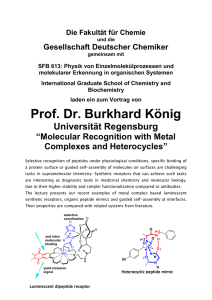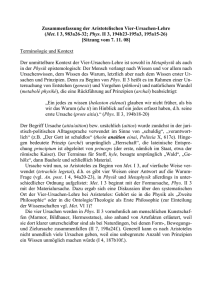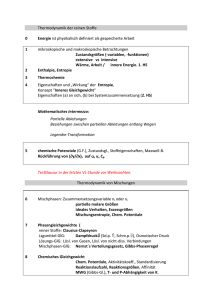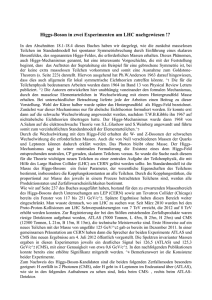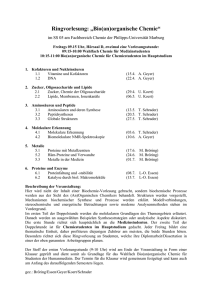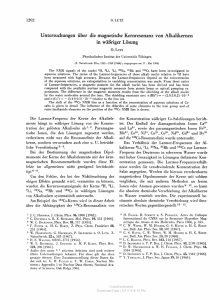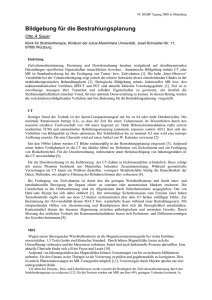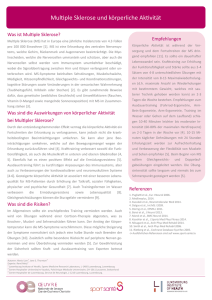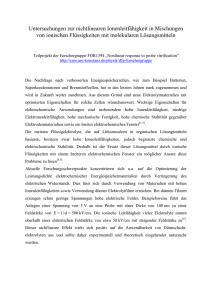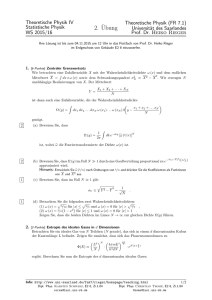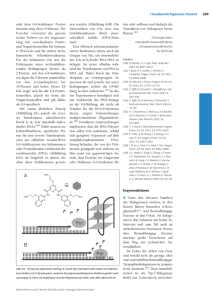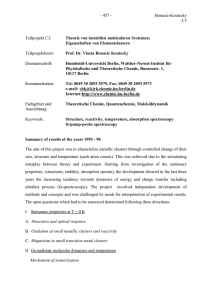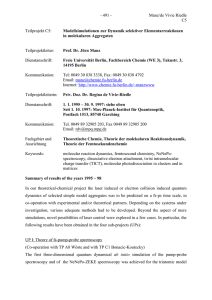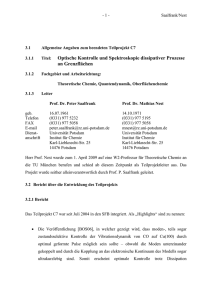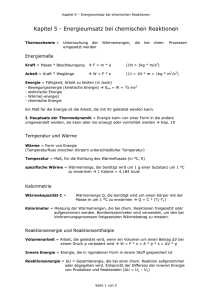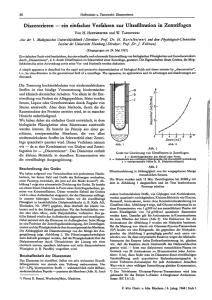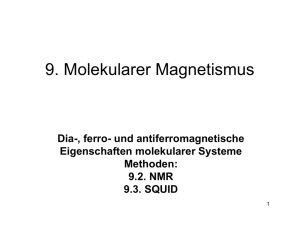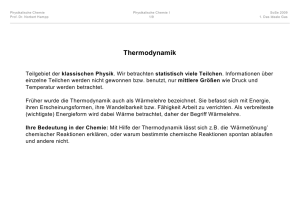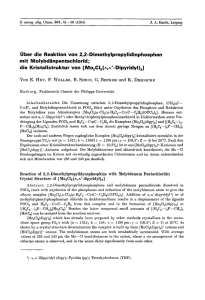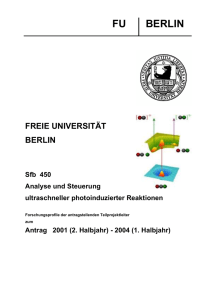Forschungsprofile der Projektleiter
Werbung
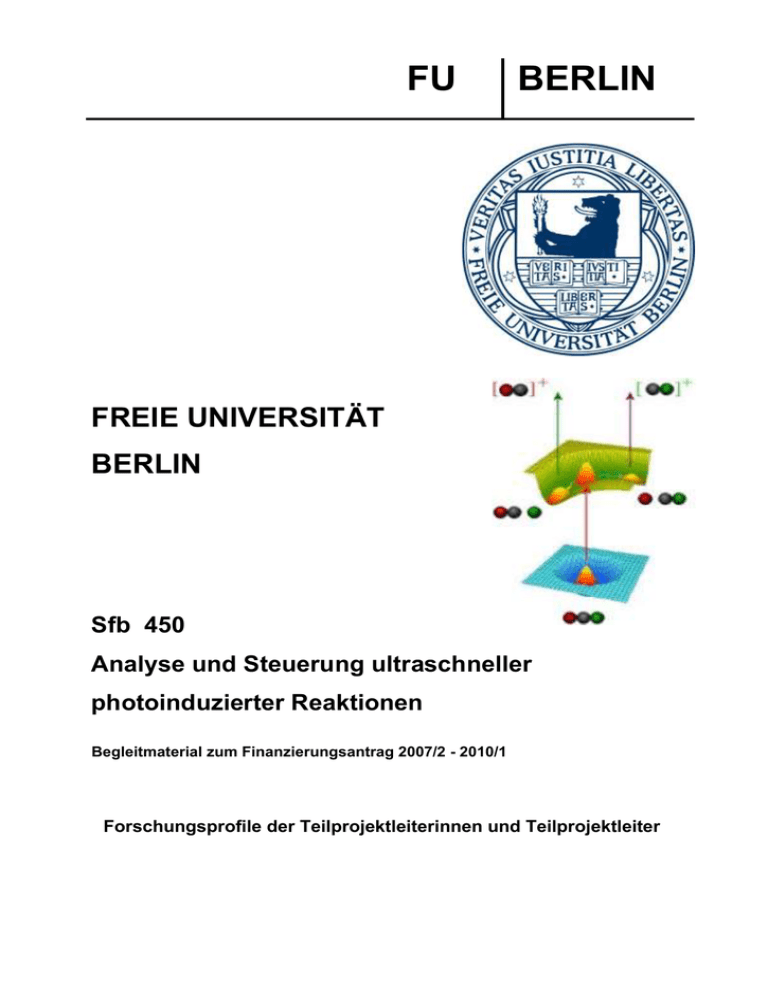
FU BERLIN FREIE UNIVERSITÄT BERLIN Sfb 450 Analyse und Steuerung ultraschneller photoinduzierter Reaktionen Begleitmaterial zum Finanzierungsantrag 2007/2 - 2010/1 Forschungsprofile der Teilprojektleiterinnen und Teilprojektleiter -2- -3- Inhaltsverzeichnis Forschungsprofile der Projektleiterinnen und Projektleiter Bonačić-Koutecký ..................................................................................................................3 Bovensiepen ........................................................................................................................... 6 Elsässer ...................................................................................................................................8 Ernsting ................................................................................................................................ 10 Frischkorn............................................................................................................................. 12 Gerber ...................................................................................................................................14 González ............................................................................................................................... 16 Groß ......................................................................................................................................18 von Helden ........................................................................................................................... 20 Hertel ....................................................................................................................................22 Heyne ...................................................................................................................................24 Jortner ...................................................................................................................................26 Koch .....................................................................................................................................30 Kosloff ..................................................................................................................................32 Kühn .....................................................................................................................................34 Laarmann .............................................................................................................................. 36 Lasser ...................................................................................................................................38 Lindinger .............................................................................................................................. 40 Manz .....................................................................................................................................42 May.......................................................................................................................................44 Meijer ...................................................................................................................................46 Nest.......................................................................................................................................48 Nibbering .............................................................................................................................. 50 Nordmeier............................................................................................................................. 52 Plenge ...................................................................................................................................54 Rühl ......................................................................................................................................56 Saalfrank............................................................................................................................... 58 Saenz ....................................................................................................................................60 Schmidt.................................................................................................................................62 Schütte ..................................................................................................................................64 Schultz, Thomas ...................................................................................................................66 Schulz, Claus-Peter ..............................................................................................................68 Schwentner ........................................................................................................................... 70 Siebert...................................................................................................................................72 Wöste....................................................................................................................................74 Wolf......................................................................................................................................76 -4- Prof. Dr. Vlasta Bonačić-Koutecký, (geb. Bonačić) Born 21.07.1943 in Split, Croatia Curriculum vitae: 2006 Fellowship of Japan Society for the promotion of Science. 2004 Professeur invité CNRS, Lyon. 1999 Miller Professor in “The Miller Institute for Basic Research in Science”, University of California at Berkeley. since 1994 Professor of Physical and Theoretical Chemistry at the Humboldt-Universität zu Berlin. 1982-1994 Professor in Chemistry Department at the Freie Universität Berlin. 1979-1980 Researcher at Gesamthochschule Wuppertal. 1977 Habilitation in Theoretical Chemistry at the Freie Universität Berlin. 1973-1979 Assistant Professor in Chemistry Department at the Freie Universität Berlin. 1971-1973 Postdoctoral research at the Belfer Graduate School of Science, Yeshiva University, New York, USA. 1968-1971 PhD work at Chemistry Department of the Johns Hopkins University, Baltimore, USA. 1968 Master Degree in Theoretical Chemistry, University of Zagreb. 1967 Diploma in Physics at Natural Science Faculty, University of Zagreb. Honors, awards and activities in the scientific community: since 2005 since 2004 Member of the Scientific Advisory Board of BESSY. Coordinator of Recearch Training Group GRK 1025 “Fundamentals and functionality of size and interface controlled materials: spin- and optoelectronics”. since 2003 Member of Medical Senat of Charité – Universitätsmedizin Berlin. since 2001 Member of Sfb 450 “Analysis and Control of Ultrafast Photoinduced Reactions”. since 2001 Member of “Center of Biophysics and Bioinformatics” of the HumboldtUniversity. since 2001 Coordinator of International Humboldt Graduate School on “Structure, Function and Application of New Materials”. since 1998 Member of Academic Senat of Humboldt-Universität zu Berlin. 1996 – 1998 Dean of Natural Science Faculty I of the Humboldt-Universität zu Berlin. Referee of grant agencies (national and international); Co-Editor of Chemical Physics Letters; Chair and/or member of the program committees of numerous international conferences. Major research areas: Ab initio quantum chemistry; Quantum chemistry molecular dynamics “on the fly” (adiabatic and nonadiabatic); Wigner distribution approach; Chemical reaction control or laser selective chemistry of nanoclusters with tailored light fields (ultrashort laser pulse shaping); Optical properties and optimal control of hybrid metal-biomolecule systems; Photophysical and photochemical size selective properties of embedded metallic clusters and their potential for optoelectronics; Structure-reactivity relationships of metal oxide clusters as foundations for nanoscale catalytic materials; Influence of metal ions on conformational changes in proteins; Photostabilization of ultracold molecules by optimal control. -5- Cooperations: Numerous cooperations with universities and research institutions in Germany and worldwide, in particular: Collaborative Research Center Sfb 450 (FU Berlin), DFG Research Training groups 1025 (HU Berlin), International Humboldt Graduate School, DFG Research group 1153, Tel Aviv University (Prof. J. Jortner), University of Boulder (Prof. J. Michl, Humboldt awardee), Penn State University (Prof. A. W. Castleman Jr., Humboldt awardee), University of Milan (Prof. P. Fantucci, Humboldt awardee), University of Lyon (Prof. M. Broyer, Humboldt awardee). 10 publications out of 50 published in peer-reviewed journals since 2001 I. Compagnon, T. Tabarin, R. Antoine, M. Broyer, P. Dugourd, R. Mitrić, J. Petersen, V. Bonačić-Koutecký: Spectroscopy of Isolated, Mass-Selected Tryptophan-Ag3+ Complexes: A Model for Photoabsorption Enhancement in Nanoparticle-Biomolecule Hybrid Systems, J. Chem. Phys.125, 164326 (2006). [2] C. Bürgel, R. Mitrić, V. Bonačić-Koutecký: Emissive Properties of Silver Particles at Silver Oxide Surface, Appl Phys. A, 82, 117 (2006). [3] V. Bonačić-Koutecký, R. Mitrić, T. Bernhardt, L. Wöste, J. Jortner: Analysis and Control of Ultrafast Dynamics in Clusters: Theory and Experiment, Advances in Chem. Phys., 132, 179 (2006). [4] R. Mitrić, V. Bonačić-Koutecký, J. Pittner, H. Lischka: Ab initio nonadiabatic dynamics study of ultrafast radiationless decay over conical intersections illustrated on the Na3F cluster, J. Chem. Phys., 125, 024303 (2006). [5] V. Bonačić-Koutecký, R. Mitrić: Theoretical Exploration of Ultrafast Dynamics in Atomic Clusters; Analysis and Control, Chemical Reviews, 105, 11 (2005). [6] E. Franzini, L. De Gioia, P. Fantucci, G. Zampella and V. Bonačić-Koutecký: DFT investigation of the copper binding site in the octarepeat domain of the prion protein, Inorg. Chem. Comm., 6, 650 (2003) [7] R. Mitrić, M. Hartmann, J. Pittner, V. Bonačić-Koutecký: New strategy for optimal control of femtosecond pump-dump processes, J. Phys. Chem. A, 106, 10477 (2002). [8] Š. Vajda, C. Lupulescu, A. Merli, F. Budzyn, L. Wöste, M. Hartmann, J. Pittner and V. Bonačić-Koutecký: Observation and Theoretical Description of Periodic Geometric Rearrangement in Electronically Excited Nonstoichiometric Sodium-Fluoride Clusters, Phys. Rev. Lett., 89, 213404, (2002). [9] M. Hartmann, J. Pittner, V. Bonačić-Koutecký: Ab initio nonadiabatic dynamics involving conical intersection combined with Wigner distribution approach to ultrafast spectroscopy illustrated on Na3F2 cluster, J. Chem. Phys., 114, 2123 (2001). [10] M. Hartmann, J. Pittner, V. Bonačić-Koutecký: Ab Initio Adiabatic Dynamics Involving Excited States Combined with Wigner Distribution Approach to Ultrafast Spectroscopy Illustrated on Alkali Halide Clusters, J. Chem. Phys., 114, 2106 (2001). [1] -6- PD Dr. Uwe Bovensiepen Freie Universität Berlin Arbeitsgebiet: Ultrakurzzeitdynamik an Grenzflächen kondensierter Materie Kurzbiographie: Geboren 1969, Physikstudium an der FU Berlin 1990 – 96, Doktorarbeit an der FU Berlin bei Prof. K. Baberschke zum Thema "Phasenübergänge in magnetischen Monolagen und austauschgekoppelten Schichten", Promotion 2000, Postdoc am Fritz-Haber- Institut der MPG bei Dr. M. Wolf 2000, wiss. Assistent an der FU Berlin 2001 - 2006, Untersuchungen zur Femtosekunden-Dynamik elektronischer, phononischer und magnonischer Anregungen an Festkörpergrenzflächen, Organisation des 355. Heraeus-Seminars 2005, Habilitation 2005, Forschungsaufenthalte an der University of Pittsburgh bei Prof. H. Petek 2005 und 2006, Privatdozent am Fachbereich Physik und Heisenbergstipendiat der DFG seit 2006 Forschungsschwerpunkte: Die Untersuchungen zielen auf die mikroskopischen Wechselwirkungsmechanismen und der zugrundeliegenden Dynamik von optisch angeregten Elektronen, sowie ihrer Wechselwirkung mit Spin- und Kernfreiheitsgraden an Grenzflächen kondensierter Materie. Hierfür werden Experimente mit zeitaufgelöster direkter Photoemission bzw. Zwei-Photonen-Photoemission durchgeführt. Ergänzend werden Methoden der nicht-linearen und linearen Optik verwendet. Die Forschungsschwerpunkte sind im Einzelnen: Ultrakurzzeitdynamik optisch angeregter Elektronen in molekularen Adsorbatschichten: Mechanismen des Elektronentransfers, der Elektronenlokalisierung und -solvatisierung werden mit zeit- und winkelaufgelöster Photoelektronen-Spektroskopie analysiert. Ultraschnelle Ladungsträgerdynamik in niederdimensionalen Metallstrukturen: Die Relaxationsmechanismem optisch angeregter Elektronen werden mit zeit- und winkelaufgelöster Zwei-Photonen-Photoemission studiert, um ein fundamentales Verständnis der Lebensdauern heißer Elektronen zu entwickeln. Ultraschnelle Spindynamik an ferromagnetischen Metalloberflächen: Mittels linearer und nichtlinearer zeitaufgelöster Verfahren werden die Wechselwirkung von optisch angeregten Elektronen mit Kern- und Spinfreiheitsgraden untersucht. Im Mittelpunkt stehen Elektron-Magnon-Streuung, Elektron-Phonon-Kopplung, Energiedissipation sowie der Einfluss kohärenter Phononen auf das geordnete Spinsystem. Elektronische Korrelation in Festkörpern: Mit zeit- und winkelaufgelöster Photoemission werden durch heiße Elektronen ausgelöste Ordnungsübergänge in Supraleitern, sowie in Mott- und Peierls-Isolatoren untersucht. -7- Ausgewählte Publikationen der letzten 5 Jahre: [1] L. Perfetti, P. A. Loukakos, M. Lisowski, U. Bovensiepen, H. Berger, S. Biermann, P. S. Cornaglia, A. Georges, and M. Wolf: Time evolution of the electronic structure of TaS2 through the insulator-metal transition, Phys. Rev. Lett. (2006, in press) [2] U. Bovensiepen: Ultrafast dynamics of coherent optical lattice and spin excitations at the Gd(0001) surface, Appl. Phys. A 82, 395 (2006) [3] J. Stähler, C. Gahl, U. Bovensiepen, M. Wolf: Ultrafast electron dynamics at ice/metal interfaces: Competition between heterogeneous electron transfer and solvation, J. Chem. Phys. 110, 9637 (2006) [4] M. Lisowski, P. A. Loukakos, A. Melnikov, I. Radu, L. Ungureanu, M. Wolf, U. Bovensiepen: Electron and spin dynamics on Gd(0001) by time-resolved photoemission and magnetooptics, Phys. Rev. Lett. 95, 1370402 (2005). [5] U. Bovensiepen: Ultrafast electron transfer, localization and solvation at ice-metal interfaces: Correlation of structure and dynamics, Prog. Surf. Sci. 78, 87 (2005) [6] P. S. Kirchmann, P. A. Loukakos, U. Bovensiepen, M. Wolf: Ultrafast electron dynamics studied with time-resolved photoemission: Intra- and interband scattering in C6F6/Cu(111). Special issue on photoemission, New J. Phys. 7, 113 (2005). [7] U. Bovensiepen, C. Gahl, J. Stähler, M. Wolf: Ultrafast electron dynamics in amorphous and crystalline D2O layers on Ru(001), Surf. Sci. 584, 90 (2005). [8] U. Bovensiepen, A. Melnikov, I. Radu, O. Krupin, K. Starke, M. Wolf, E. Matthias: Coherent surface and bulk vibrations induced by femtosecond laser excitation of the Gd(0001) surface state, Phys. Rev. B 69, 235417 (2004). [9] A. Melnikov, I. Radu, U. Bovensiepen, O. Krupin, K. Starke, E. Matthias, M. Wolf: Coherent optical phonons and parametrically Coupled magnons induced by femtosecond laser excitation of the Gd(0001) surface, Phys. Rev. Lett. 91, 227403 (2003). [10] U. Bovensiepen, C. Gahl, M. Wolf: Solvation dynamics and evolution of the spatial extent of photoinjected electrons in D2O/Cu(111), J. Phys. Chem. B 107, 8706 (2003). [11] C. Gahl, U. Bovensiepen, C. Frischkorn, M. Wolf: Ultrafast dynamics of electron localization and solvation in ice layers on Cu(111), Phys. Rev. Lett. 89, 107402 (2002). -8- Prof. Dr. rer. nat. Thomas Elsässer Max-Born-Institut für Nichtlineare Optik und Kurzzeitspektroskopie Arbeitsgebiet: Molekül- und Festkörperphysik, Ultrakurzzeitspektroskopie Kurzbiographie: Geboren 1957 in Tübingen, 1976-1982 Studium der Physik an der Universität Heidelberg und der Technischen Universität München, 1982 Diplom in Physik, 1986 Promotion an der TU München bei Prof. Wolfgang Kaiser, 1986-1993 Akademischer Rat und Oberrat am Physik Department der TU München, 1990 Forschungsaufenthalt bei den AT&T Bell Laboratories, Holmdel, NJ, USA, 1991 Habilitation an der TU München, seit 1993 Direktor am Max-Born-Institut, seit 1994 C4-S-Professur für Experimentalphysik an der HumboldtUniversität zu Berlin, 2004 Professeur invité an der Ecole Normale Supérieure, Paris. Abgelehnte Rufe: Ordinariat für Experimentalphysik an der Universität Zürich, C4-Professur für Experimentalphysik an der Universität Stuttgart. Auszeichnungen und Sonderfunktionen: 1986 Dissertationspreis des Bundes der Freunde der TU München, 1991 Rudolf-Kaiser-Preis, 1995 Otto-Klung-Preis für Physik. Mitglied Apparateausschuss der DFG, Koordinator des DFG-Schwerpunktprogramms 1134, Vertrauensdozent der Studienstiftung des deutschen Volkes, Mitglied wiss. Beirat BESSY, Mitglied Editorial Board der Zeitschriften Applied Physics A, Chemical Physics Letters, Chemical Physics, Program Chair der Konferenz Ultrafast Phenomena XI (1998), General Chair der Konferenz Ultrafast Phenomena XII (2000), Chairman Int. Conference on Transient Chemical Structures in Dense Media 2005, Mitglied der Programmkomitees zahlreicher internationaler Konferenzen. Forschungsschwerpunkte: Ultrakurzzeitphänomene in kondensierter Materie, d.h. Flüssigkeiten, polyatomare Moleküle, anorganische und organische Festkörper und Nanostrukturen: Erzeugung und Anwendung ultrakurzer Lichtimpulse in einem extrem breiten Spektralbereich (THz bis Röntgen), Nichtgleichgewichtsdynamik elementarer Anregungen in Festkörpern, Strukturelle Dynamik von Festkörpern im Ultrakurzzeitbereich, Schwingungsanregungen und schwingungsinduzierte Prozesse in Wasserstoffbrücken und anderen molekularen Systemen. -9- Kooperationen: Zahlreiche Kooperationen mit Universitäten und Forschungsinstituten im In- und Ausland, u.a. R.J. Dwayne Miller, University of Toronto, Canada, S. Mukamel, UC Irvine, USA. Ausgewählte Veröffentlichungen (2002-2006) [1] P. Gaal, K. Reimann, M. Woerner, T. Elsaesser, R. Hey, K. H. Ploog: Nonlinear terahertz response of n-type GaAs, Phys. Rev. Lett. 96, 187402/1-4 (2006). [2] S. Ashihara, N. Huse, A. Espagne, E. T. J. Nibbering, T. Elsaesser: Vibrational couplings and ultrafast relaxation of the O-H bending mode in liquid H2O, Chem. Phys. Lett. 424, 66 (2006). [3] M. L. Cowan, B. D. Bruner, N. Huse, J. R. Dwyer, B. Chugh, E. T. J. Nibbering, T. Elsaesser, R. J. D. Miller: Ultrafast memory loss and energy redistribution in the hydrogen bond network of liquid H2O, Nature 434, 199 (2005). [4] N. Huse, B. D. Bruner, M. L. Cowan, J. Dreyer, E. T. J. Nibbering, R. J. D. Miller, T. Elsaesser: Anharmonic couplings underlying the ultrafast vibrational dynamics of hydrogen bonds in liquids, Phys. Rev. Lett. 95, 147402 (2005). [5] M. Bargheer, N. Zhavoronkov, Y. Gritsai, J. C. Woo, D. S. Kim, M. Woerner, T. Elsaesser: Coherent atomic motions in a nanostructure studied by femtosecond x-ray diffraction, Science 306, 1771 (2004). [6] E. T. J. Nibbering, T. Elsaesser: Ultrafast vibrational dynamics of hydrogen bonds in the condensed phase, Chem. Rev. 104, 1887 (2004). [7] K. Heyne, N. Huse, J. Dreyer, E. T. J. Nibbering, T. Elsaesser, S. Mukamel: Coherent low-frequency motions of hydrogen bonded acetic acid dimers in the liquid phase, J. Chem. Phys. 121, 902 (2004). [8] C. W. Luo, K. Reimann, M. Woerner, T. Elsaesser, R. Hey, K. H. Ploog: Phaseresolved nonlinear response of a two-dimensional electron gas under femtosecond intersubband excitation, Phys. Rev. Lett. 92, 047402 (2004). [9] N. Huse, K. Heyne, J. Dreyer, E. T. J. Nibbering, T. Elsaesser: Vibrational multilevel quantum coherence due to anharmonic couplings in intermolecular hydrogen bonds, Phys. Rev. Lett. 91, 197401/1-4 (2003). [10] J. Stenger, D. Madsen, P. Hamm, E. T. J. Nibbering, T. Elsaesser: A photon echo peak shift study of liquid water, J. Phys. Chem. A 106, 2341 (2002). - 10 - Prof. Nikolaus P. Ernsting, PhD (*26.09.1950) Humboldt-Universität zu Berlin since 1993 1972 Professor (C4) for Physical Chemistry (Femtosecond Spectroscopy) at Humboldt-Universität zu Berlin, Department of Chemistry Research Staff in Laserphysics (Prof. F.P. Schäfer) at Max-Planck-Institut für biophysikalische Chemie in Göttingen Postdoc at the University of Western Ontario, Canada (Prof. J.C.D. Brand) PhD thesis at Heriot-Watt University, Edinburgh, UK, on the spectroscopy of nitrosomethanes (Profs. B.G. Gowenlock, J. Pfab) Diploma in (theoretical) chemistry at Bonn University (Prof. S. D. Peyerimhoff) Exchange year at University of Dundee, UK (Prof. A. D. Walsh) Awards 1998 Leibniz Prize of the Deutsche Forschungsgemeinschaft 1981 - 1993 1979 - 1981 1977 - 1979 1976 10 selected publications from the group since 2001: [1] Ultrafast Dynamics in DNA: "Fraying" at the End of the Helix D. Andreatta, S. Sen, J.L. Pérez Lustres, S.A. Kovalenko, N.P. Ernsting, C.J. Murphy, R.S. Coleman and M.A. Berg J. Am. Chem. Soc. 128 (21), 6885 (2006) [2] Detecting Electronic Coherence in Excited-State Electron Transfer in Fluorinated Benzenes S.A. Kovalenko, A.L. Dobryakov, V. Farztdinov Phys. Rev. Lett. 96, 068301-1 (2006) [3] Large Dynamic Stokes Shift of DNA Intercalation Dye Thiazole Orange has Contribution from a High-Frequency Mode Karunakaran Venugopal, Luis Pérez Lustres, Lijuan Zhao, Nikolaus P. Ernsting, Oliver Seitz J. Am. Chem. Soc. 128, 2954 (2006) [4] Ultrafast Solvation of N-Methyl-6-quinolone Probes Local IR Spectrum, Luis Pérez Lustres, Sergey A. Kovalenko, Manuel Mosquera, Tamara Senyushkina, Wolfgang Flasche, Nikolaus P. Ernsting Angew. Chem. Int. Ed. 44, 2 (2005) [5] Coherent and Sequential Contributions to Femtosecond Transient Absorption Spectra of a Rhodamine Dye in Solution, A.L. Dobryakov, Sergey A. Kovalenko, Nikolaus P. Ernsting J. Chem. Phys. 123, 044502 (2005) - 11 - [6] Power-Law Solvation Dynamics in DNA over Six Decades in Time, Daniele Andreatta, J. Luis Pérez Lustres, Sergey A. Kovalenko, Nikolaus P. Ernsting, Catherine J. Murphy, Robert S. Coleman and Mark A. Berg J. Am. Chem. Soc. 127, 7270, (2005) [7] Femtosecond Fluorescence Spectroscopy by Upconversion with tilted Gate Pulses Lijuan Zhao, J. Luis Pérez Lustres, Vadim Farztdinov, Nikolaus P. Ernsting PCCP 7, 1716 (2005) [8] Electronic and Vibrational Coherence Effects in Broadband Tansient Absorption Spectroscopy with chirped Supercontinuum Probing A. L. Dobryakov, S. A. Kovalenko and N. P. Ernsting J. Chem. Phys. 119, 988 (2003) [9] Rotational friction kernel in water from the femtosecond time-resolved optical Kerr effect of acetonitrile/water mixtures Niko P. Ernsting, George M. Photiadis, Horst Hennig, and Thomas Laurent J. Phys. Chem. A 106, 9159 (2002) [10] Cooling dynamics of an optically excited molecular probe in solution from femtosecond broadband transient absorption spectroscopy S. A. Kovalenko, R. Schanz, H. Hennig, and N. P. Ernsting J. Chem. Phys. 115, 3256 (2001) - 12 - Dr. Christian Frischkorn Freie Universität Berlin Arbeitsgebiet: Oberflächenphysik, Ultrakurzzeitdynamik an Grenzflächen Kurzbiographie: Geboren 1966, Physikstudium 1986–93 TU Darmstadt, Gastaufenthalt 1993–94 an der East China Normal University in Shanghai bei Prof. Zu-Geng Wang und Hui-Rong Xia, Doktorarbeit am Max-Planck-Institut für Strömungsforschung in Göttingen bei Prof. U. Buck zum Thema "Photodissoziation von HBr-Molekülen und HBr-Clustern", Promotion 1997, Postdoc 1998–2000 University of California at Berkeley bei Prof. D. Neumark, seit 11/2000 wiss. Mitarbeiter (Habilitand AG Wolf) an der FU Berlin, Arbeiten zu Femtosekundenlaserinduzierten Oberflächenreaktionen und ultraschneller Ladungsträgerdynamik in Gasen und Festkörpern untersucht mit zeitaufgelöster THz-Spektrokopie. Auszeichnungen: Postdoktoranden-Stipendium der Deutschen Akademie der Naturforscher Leopodina 1998– 2000 Forschungsschwerpunkte: Die Forschungsprojekte sollen zu einem tieferen Verständnis auf mikroskopischer Ebene der elementaren elektronischen Prozesse und Kernbewegungen auf Oberflächen führen, die mit einem ultrakurzen Laserpuls ausgelöst werden. Dabei kommen diverse fs-Pump-ProbeTechniken zum Einsatz: (i) Zwei-Puls-Korrelationsmessungen der Ausbeute einer laserinduzierten chemischen Oberflächenreaktion, (ii) optische nichtlineare Schwingungsspektroskopie an einzelnen Reaktanden, sowie (iii) zeitaufgelöste Messungen niederenergetischer Anregungen an Oberflächen und im Volumen dünner Filme. Forschungsschwerpunkte sind: Femtochemie an Oberflächen: Die Mechanismen Femtosekunden-laserinduzierter Oberflächenreaktionen von adsorbierten Reaktanden auf Einkristalloberflächen werden im Hinblick auf eine gezielte Einflussnahme der Reaktion (Reaktionskontrolle) untersucht. Ultrakurzzeitdynamik von Adsorbatschwingungen auf Oberflächen: Als Abfragetechnik wird die zeitaufgelöste Schwingungsspektroskopie mittels Summenfrequenzerzeugung eingesetzt, um eine Oberflächenreaktion in ihren Elementarschritten zeitlich aufzulösen. Ultraschnelle Ladungsträgerdynamik untersucht mit zeitaufgelöster THz-Spektroskopie: Die Ultrakurzzeitdynamik niederenergetischer Elektronen in dünnen Filmen (niederdimensionaler Proben) werden bezüglich Anregung und Energie- bzw. Stromrelaxation untersucht. THz-Strahlung auch im Pump-Prozess zu verwenden bzw. oberflächensensitiv zu erzeugen sind weitere Aspekte dieses Bereichs der Forschungsaktivitäten. - 13 - Ausgewählte Publikationen der letzten 5 Jahre: [1] C. Frischkorn and M. Wolf, Femtochemistry at Metal Surfaces: Nonadiabatic Reaction Dynamics, Chem. Rev. 106, 4207 (2006). [2] A. C. Luntz, M. Persson, S. Wagner, C. Frischkorn, and M. Wolf, Femtosecond laser induced associative desorption of H2 from Ru(0001): Comparison of "first principles" theory with experiment, J. Chem. Phys. 124 , 244702 (2006). [3] L. Perfetti, T. Kampfrath, F. Schapper, A. Hagen, T. Hertel, C. Aguire, P. Desjardins, R. Martel, C. Frischkorn, and M. Wolf, Ultrafast dynamics of delocalized and localized electrons in carbon nanotubes, Phys. Rev. Lett. 96, 027401 (2006). [4] T. Kampfrath, L. Perfetti, F. Schapper, C. Frischkorn, and M.Wolf, Strongly coupled optical phonons in the ultrafast dynamics of electronic energy and current relaxation in graphite, Phys. Rev. Lett. 95, 187403 (2005). [5] S. Wagner, C. Frischkorn, M. Wolf, M. Rutkowski, H. Zacharias, and A. C. Luntz, Energy partitioning in the femtosecond-laser-induced associative D2 desorption from Ru(0001), Phys. Rev. B 72 , 205404 (2005). [6] C. Frischkorn, Microscopic understanding of an ultrafast photochemical surface reaction: Hads + Hads H2,gas on Ru(001), Surf. Sci. 593 , 67 (2005). [7] D.N. Denzler, C. Frischkorn, M. Wolf, and G. Ertl, Surface femtochemistry: Associative desorption of hydrogen from Ru(001) induced by electronic transitions, J. Phys. Chem. B 108, 14503 (2004). [8] D.N. Denzler, C. Frischkorn, C. Hess, M. Wolf, and G. Ertl, Electronic excitation and dynamic promotion of a surface reaction, Phys. Rev. Lett. 91, 226102 (2003). [9] D.N. Denzler, C. Hess, R. Dudek, S. Wagner, C. Frischkorn, M. Wolf, and G. Ertl, Interfacial structure of water on Ru(001) investigated by vibrational spectroscopy, Chem. Phys. Lett. 376, 618 (2003). [10] C. Gahl, U. Bovensiepen, C. Frischkorn, and M. Wolf: Ultrafast dynamics of electron localization and solvation in ice layers on Cu(111), Phys. Rev. Lett. 89, 107402 (2002). - 14 - Professor R.B. Gerber The Hebrew University of Jerusalem, Israel Field of Research: Theoretical and Computational Chemistry; Molecular Reaction Dynamics; Molecular Spectroscopy Short Biography Born in 1944. B.Sc. in Chemistry (with excellence), Hebrew University of Jerusalem, 1965. D.Phil., University of Oxford, England 1968. Thesis supervisor: Professor C.A. Coulson. Postdoctoral C.A. Coulson. Postdoctoral Research Associate, Harvard University, 1968/69. Postdoctoral advisor: Professor M. Karplus. Senior Scientist at the Weizmann Institute of Science, Rehovot, Israel, 1969-75. Associate Professor of Chemistry, Hebrew University of Jerusalem, 1976-80. Professor of Chemistry, Hebrew University, from 1980. Saerree K. and Louis P. Fiedler Chair in Chemistry, Hebrew University, from 1989. Professor of Chemistry, University of California, Irvine, from 1990. Present Positions Saerree K. and Louis P. Fiedler Chair in Chemistry, Hebrew University of Jerusalem, Israel; Professor of Chemistry, University of California at Irvine, USA Current Projects *Sfb 450, "Analysis and Control of Ultrafast Photoinduced Reactions", Sub-project C1, cooperation with Professor J. Manz, FU Berlin. From 1998. *Israel Science Foundation, "Novel Rare-Gas Compounds" from Oct. 2003. For 4 years. *US-Israel Binational Science Foundation, "Ab Initio Anharmonic Calculations of Biomolecules", in cooperation with Professor M.S. Gordon, Iowa State University, USA. From Sept. 2005, for 4 years. *State of Niedersachsen, Germany/Volkswagen Foundation, Hannover: "Unraveling the Influence of Water Interfaces on Atmospheric Chemistry", in cooperation with Professor B. Abel, University of Göttingen and Professor U. Buck, MPI Göttingen. From Jan. 06, for two years. Research Group (July 06) o* Arik Cohen, Ph.D. student; o* Hagai Eshet, M.Sc. student (till August 06); * Y. Miller, Ph. Student; o* Dr. Brina Brauer, Postdoctoral Research Associate; * Michal Steinberg, Ph. Student; * Dr. Iyad Suwan, Postdoctoral Research Associate; * Elad Segev, Ph.D. Student; * Moshe Goldstein, Ph.D. Student; * Liat Pele, M.Sc. student; * Liran Smiri, M.Sc. student; * Adeyemi Adesokan, Ph.D. student; (o indicates research group members involved in Sfb 450 projects) Research Fields (a) Dynamics of photochemical processes in low-temperature clusters and solids; (b) Novel compounds and materials of the noble gas elements; (c) Vibrational Spectroscopy of large molecules and clusters. Spectroscopy and the development of new potential surfaces for biological molecules; (d) Reaction mechanisms and rates of atmospherically important processes. - 15 - Cooperations in Sfb 450 J. Manz (FU Berlin) – TPC1; N. Schwentner (FU Berlin) – TPA2; G. van Helden and G. Meijer (FHI) – B7, just beginning. Selected Papers 2002-2006 [1] M. Bargheer, M.Y. Niv, R.B. Gerber and N. Schwentner; Ultrafast Solvent-Induced SpinFlip and Non-Adiabatic Coupling: ClF in Argon Solids; Phys. Rev. Lett. 89, 108301/1-4 (2002) [2] M. Bargheer, R.B. Gerber, M.V. Korolkov, O. Kűhn, J. Manz, M. Schröder and N. Schwentner; Subpicosecond Spin-Flip Induced by the Photodissociation Dynamics of ClF in an Ar Matrix; Phys. Chem. Chem. Phys. 4, 5554-5562 (2002) [3] J. Lundell, A. Cohen and R.B. Gerber; Quantum Chemical Calculations on Novel Molecules from Xenon Insertion into Hydrocarbons; J. Phys. Chem. A 106, 11950-11955 (2002) [4] M. Petterson, L. Khriachtchev, A. Lignell, M. Räsänen, Z. Bihary and R.B.Gerber; HKrF in Solid Krypton; J. Chem. Phys. 116, 2508-2515 (2002) [5] L. Khriachtchev, H. Tanskanen, A. Cohen, R.B. Gerber, J. Lundell, M. Pettersson, H. Kiljunen and M. Räsänen; A Gate to Organokrypton Chemistry: HKrCCH; J. Am. Chem. Soc. (Communication) 125, 6876-6877 (2003) [6] R.B. Gerber; Formation of Novel Rare-Gas Molecules in Low-Temperature Matrices; Ann. Rev. Phys. Chem. 55, 55-78 (2004) [7] B. Brauer, G.M. Chaban and R.B. Gerber; Spectroscopically-Tested, Improved SemiEmpirical Potentials for Biological Molecules: Calculations for Glycine, Alanine and Proline; Phys. Chem. Chem. Phys. 6, 2543-2556 (2004) [8] D. Shemesh and R.B. Gerber; Different Chemical Dynamics for Different Conformers of Biological Molecules: Photoionization of Glycine; J. Chem. Phys. (Communication) 122, 241104-1 (2005) [9] H. Eshet, M.A. Ratner and R.B. Gerber; Selective Energy and Phase Transfer in the Photodissociation of I 2 in Argon Clusters: Quantum Dynamics Simulations; Chem. Phys. Lett. 431, 199-203 (2006) [10] E. Segev, M. Grumbach and R.B. Gerber; Evolution of Conformational Changes in the Dynamics of Small Biological Molecules: A Hybrid MD/RRK Approach; Phys. Chem. Chem. Phys. 8, 4915-4923 (cover article) (2006) - 16 - PD Dr. Leticia González Geboren 17.März 1971 in Madrid, Spanien Wissenschaftliche Laufbahn 1989 - 1994 1994 - 1995 Studium der Chemie an der Universidad Autónoma de Madrid, Spanien Masterarbeit in Chemie am King’s College London, UK, bei Prof. Dr. M. A. Robb Doktorarbeit am Chemistry Department, Universidad Autónoma de Madrid, Spanien, bei Prof. Dr. M. Yáñez und Prof. O. Mó Postdoktorand am Chemistry Department, Universidad Autónoma de Madrid, Spanien, bei Prof. Dr. M. Yáñez und Prof. O. Mó Habilitandin und Privatdozentin am Institut für Chemie und Biochemie, Freie Universität Berlin (Mentor: Prof. Dr. Jörn Manz) Gastprofessorin am Institut für Chemie und Biochemie, Freie Universität Berlin Heisenbergstipendiatin am Institut für Chemie und Biochemie, Freie Universität Berlin 1995 - 1998 1998 - 1999 1999 - 2005 2005 - 2006 seit 2007 Auszeichnungen 1994 Erasmus Stipendium, EU 1995 PhD Stipendium, Spanish Ministry of Education and Science 1999 “Premio Extraordinario de Doctorado” (Auszeichnung der Promotion als “Beste des Jahrgangs 1998/1999”), Universidad Autónoma de Madrid 1999 Alexander von Humboldt Stipendium 2004 Rosalind-Franklin Stipendium, Rijksuniversiteit Groningen, Niederlande (nicht angenommen) 2005 SIGMA-ALDRICH Auszeichnung für beste Junge Forscher der KöniglichSpanischen Chemischen Gesellschaft (RSEQ) 2005 Gastprofessur des Berliner Frauenförderprogramms 2007 Heisenberg Stipendium Wissenschaftliche Schwerpunkte Quantenchemie organischer und anorganischer Verbindungen, Photochemie, Photobiologie, Photomedizin, Reaktionsdynamik, Ultrakurzzeitchemie, lasergesteuerte Prozesse, molekulare Funktion. Kooperationen Zahlreiche Kooperationen mit Universitäten und Forschungsinstituten im In- und Ausland. - 17 - 10 Ausgewählte Veröffentlichungen der letzten 5 Jahre (von insgesamt ca. 55 Veröffentlichungen seit 1996) [1] T. Rozgonyi, L. González, Photochemistry of CH2BrCl: An ab intio and dynamical study; J. Phys. Chem. A 2002, 106, 11150-11161 [2] C. Daniel, J. Full, L. González, C. Lupulescu, J. Manz, A. Merli, S. Vajda, L. Wöste, Deciphering the reaction dynamics underlying optimal control laser fields; Science, 2003, 299, 536 – 539 [3] D. Kröner, Mohamed F. Shibl, L. González, Asymmetric laser excitation in chiral molecules: quantum simulations for a proposed experiment; Chem. Phys. Lett., 2003, 372, 242 - 248 [4] K. Hoki, M. Sato, M. Yamaki, R. Sahnoun, L. González, S. Koseki, Y. Fujimura, Chiral molecular motors ignited by femtosecond pump-dump laser pulses; J. Phys. Chem. B 2004, 108 , 4916-4291. [5] N. Elghobashi, L. González, Breaking the strong and weak bonds of OHF- using fewcycle IR+UV laser pulses; Phys. Chem. Chem. Phys. (Comm.) 2004, 6, 4071-4073, (Selected as ’Hot article’) [6] J. Full, L. González, J. Manz, Neutral-to-ionic ZEKE transition dipole couplings beyond Koopmans' picture. Application to femtosecond pump-probe spectroscopy; Chem. Phys., 2005, 314, 143-158. [7] D. Ambrosek, M. Oppel, L. González, V. May, Application of the Optimal Control Theory to Ultrafast Nonresonant Multiphoton Transitions in Polyatomic Molecules; Optical Comm. 2006, 264, 502-510 [8] N. Elghobashi, L. González, A theoretical anharmonic study of the infrared absorption spectra of FHF-, FDF-, OHF-, and ODF- anions; J. Chem. Phys., 2006, 124, 1743081/174308-12 [9] T. Rozgonyi and L. González, On the location of conical intersections in CH2BrCl using MS-CASPT2; J. Phys. Chem. A 2006, 110, 10251-10259. [10] L. González, J. Full, A first principles approach to optimal control. Theor. Chem. Acc., 2006, 116, 148-159. Special issue on "New perspectives in Theoretical Chemistry", ed. by C. J. Cramer and D. G. Truhlar. - 18 - Prof. Dr. Eberhard K. U. Groß Freie Universität Berlin Arbeitsgebiet:Dichtefunktionaltheorie, Vielteilchentheorie, zeitabhängige Phänomene Kurzbiographie: Geboren 1953, Physikstudium 1972 – 76 an der Universität Frankfurt, Promotion 1980 an der Universität Frankfurt bei Prof. R. M. Dreizler, wissenschaftlicher Mitarbeiter 1980 – 84 an der Universität Frankfurt, Postdoc 1984 – 86 an der University of California, Santa Barbara, bei Prof. W. Kohn, 1986 Forschungsaufenthalt am Max-Planck-Institut für Festkörperforschung, Stuttgart, 1986 Habilitation an der Universität Frankfurt, 1986 – 1990 Heisenbergstipendiat und Visiting Associate Professor an der University of California, Santa Barbara, 1990 – 2001 C3-Professor (Fiebiger-Professur) an der Universität Würzburg, seit 2001 C4-Professor am Fachbereich Physik der Freien Universität Berlin. Auszeichnuungen und Sonderfunktionen: Schlumberger Award with medal at the University of Cambridge 2004; visiting Fellow am Trinity College, Cambridge 2003; Benjamin Meaker Professorship at the University of Bristol 2000; International Fellowship of the Australian Research Council 1994; HeisenbergStipendium der DFG 1986; DAAD-Gastdozentur an der Universität Coimbra 1985; Stipendium der Studienstiftung des deutschen Volkes 1973 – 1979, erster Preis im Bundeswettbewerb Mathematik 1971. Mitherausgeber von „Progress in Theoretical Chemistry and Physics“; Mitglied im Lenkungsausschuss des Programms „Electronic Structure Calculations for Elucidating the Complex Atomistic Behaviour of Solids and Surfaces“ der European Science Foundation; Mitinitiator des DFG-Schwerpunktprogramms 1145 „Moderne und universelle firstprinciples-Methoden für Mehrelektronensysteme in Chemie und Physik“; deutscher Vertreter und derzeitiger Präsident im Council des CECAM (Centre Européen de Calcul Atomique et Moléculaire) in Lyon; Organisation diverser internationaler Workshops und einer NATOSchule. Forschungsschwerpunkte: Die Forschungsprojekte zielen darauf ab, materialspezifische Eigenschaften ab-initio zu berechnen. Zum einen werden die dazu erforderlichen Methoden, insbesondere die Dichtefunktionaltheorie, weiterentwickelt, zum anderen werden konkrete, besonders interessante Systeme explizit berechnet: Allgemeine Dichtefunktionaltheorie, Konstruktion verbesserter Austauschkorrelationsfunktionale, insbesondere zur Behandlung explizit zeitabhängiger Phänomene und zur Beschreibung stark korrelierter Festkörper. Berechnung der Ionisations- und Dissoziationsdynamik von Molekülen in starken Laserpulsen, sowie die optimale Kontrolle dieser Dynamik. Berechnung linearer und nichtlinearer optischer Eigenschaften von Molekülen und Festkörpern. Berechnung der Transporteigenschaften einzelner Moleküle. - 19 - Entwicklung einer Dichtefunktionaltheorie des supraleitenden Zustands, die es erlaubt, materialspezifische Eigenschaften des Supraleiters, wie etwa die kritische Temperatur, ab-initio zu berechnen. Relativistische Effekte, insbesondere Circulardichroismus. Kooperationen: University of Bristol (Prof. B. L. Györffy), Tulane University (Prof. J. Perdew), Rutgers University (Prof. K. Burke), Lund University (Prof. Ulf von Barth), University of San Sebastian (Prof. A. Rubio), University of Cagliari (Prof. S. Massidda), University of Groningen (Prof. R. van Leeuwen), Rutherford Laboratory (Dr. N. Gidopoulos), Griffith University, Brisbane (Prof. J. Dobson). Darüber hinaus ist die Gruppe ein „Knoten“ in den EU-Netzwerken „Ψk“ und „EXC!TING“, sowie im EU Network of Excellence „NANOQUANTA“. Ausgewählte Publikationen: [1] Scherz, E.K.U. Gross, H. Appel, C. Sorg, K. Baberschke, H. Wende, K. Burke, Measuring the kernel of time-dependent density functional theory with X-ray absorption spectroscopy of 3d transition metals, Phys. Rev. Lett. 95, 253006 (2005). [2] J. Werschnik, E.K.U. Gross, Tailoring laser pulses with spectral and fluence constraints using optimal control theory, J. Opt. B: Quantum Semiclass. Opt. 7, S300 (2005). [3] T. Burnus, M.A.L. Marques, and E.K.U. Gross, Time-dependent electron localization function, Phys. Rev. A (Rapid Comm.) 71, 010501 (2005). [4] S. Kurth, G. Stefanucci, C.-O. Almbladh, A. Rubio, E.K.U. Gross, Time-dependent quantum transport: A practical scheme using density functional theory, Phys. Rev. B. 72, 035308 (2005). [5] Serban, J. Werschnik, E.K.U. Gross, Optimal control of time-dependent targets, Phys. Rev. A 71, 053810 (2005). [6] M. Erdmann, E.K.U. Gross, and V. Engel, Time-dependent electron localization functions for coupled nuclear-electronic motion, J. Chem. Phys. 121, 9666 (2004). [7] Thomas Kreibich, Robert van Leeuwen, and E.K.U. Gross, Time-Dependent Variational Approach to Molecules in Strong Laser Fields, Chemical Physics 304, 183 (2004). [8] M.A.L. Marques and E.K.U. Gross, Time-Dependent Density-Functional Theory, Annu. Rev. Phys. Chem. 55, 427 (2004). [9] H. Appel, E. K. U. Gross, and K. Burke, Excitations in Time-Dependent DensityFunctional Theory, Phys. Rev. Lett. 90, 043005 (2003). [10] T. Kreibich und E.K.U. Gross, Multicomponent density-functional theory for electrons and nuclei, Phys. Rev. Lett. 86, 2984 (2001). [11] T. Kreibich, M. Lein, V. Engel und E.K.U. Gross, Even-Harmonic Generation due to Beyond-Born Oppenheimer Dynamics, Phys. Rev. Lett. 87, 103901 (2001). [12] M. Lein, E.K.U. Gross and V. Engel, Intense-field double ionization of helium: Identifying the mechanism, Phys. Rev. Lett. 85, 4707 (2000). - 20 - Gert von Helden, Ph.D. born September 15, 1965 in Wiesbaden Academic Career Since 2003 Staff researcher at the Fritz-Haber-Institut der Max-Planck-Gesellschaft, Berlin. 2000 - 2003 Research group leader at the FOM Institute for Plasmaphysics, Nieuwegein (the Netherlands). 1995 - 1999 Postdoctoral fellow at the Katholieke Universiteit Nijmegen (the Netherlands) with Prof. Dr. G. Meijer. 1994 - 1995 Postdoctoral fellow at at the University of California at Santa Barbara (USA) with Prof. Dr. M.T. Bowers. 1988 - 1994 Ph.D. thesis at the University of California at Santa Barbara (USA) with Prof. Dr. M.T. Bowers. 10 Selected Publications of the Last 5 Years from totally 128 refereed publications: [1] U. Erlekam, M. Frankowski, G. Meijer, G. von Helden: An experimental value for the B1u C-H stretch mode in benzene, J. Chem. Phys. 2006, 124, 171101. [2] I. Compagnon, J. Oomens, G. Meijer, G. von Helden: Mid-infrared spectroscopy of protected peptides in the gas phase: A probe of the backbone conformation, J. Am. Chem. Soc. 2006, 128, 3592-3597. [3] J. Oomens, N. Polfer, D.T. Moore, L. van der Meer, A.G. Marshall, J.R. Eyler, G. Meijer, G. von Helden: Charge-state resolved mid-infrared spectroscopy of a gas-phase protein, Phys. Chem. Chem. Phys. 2005, 7, 1345-1348. [4] I. Compagnon, J. Oomens, J.M. Bakker, G. Meijer, G. von Helden: Vibrational spectroscopy of a non-aromatic amino acid-based model peptide: identification of the γturn motif of the peptide backbone, Phys. Chem. Chem. Phys. 2005, 7, 13-15. [5] A. Fielicke, A. Kirilyuk, C. Ratsch, J. Behler, M. Scheffler, G. von Helden, G. Meijer: Structure determination of isolated metal clusters via far-infrared spectroscopy, Phys. Rev. Lett. 2004, 93, 023401. [6] J.M. Bakker, L. Mac Aleese, G. Meijer and G. von Helden: Fingerprint IR spectroscopy to probe amino acid conformations in the gas phase, Phys. Rev. Lett. 2003, 91, 203003. [7] G. von Helden, D van Heijnsbergen, G. Meijer: Resonant ionization using IR light: A new tool to study the spectroscopy and dynamics of gas-phase molecules and clusters, J. Phys. Chem. A 2003, 107, 1671-1688. - 21 - [8] R.G. Satink, G. Meijer, G. von Helden: Infrared spectroscopy of neutral C7H7 isomers: Benzyl and tropyl, J. Am. Chem. Soc. 2003, 125, 15714-15715. [9] D. van Heijnsbergen, A. Fielicke, G. Meijer, G. von Helden: Structure determination of gas-phase niobium and tantalum carbide nanocrystals via infrared spectroscopy, Phys. Rev. Lett. 2002, 89, 013401. [10] G. von Helden, A.G.G.M Tielens, D. van Heijnsbergen, M.A. Duncan, S. Hony, L.B.F.M. Waters, G. Meijer: Titanium carbide nanocrystals in circumstellar enviroments, Science 2000, 288, 313-316. - 22 - Prof. Dr. Ingolf V. Hertel (born 9th June, 1941 in Dresden) Full Professor of Physics (FU Berlin) and Director, Max Born Institute for Nonlinear Optics and Short Pulse Spectroscopy Scientific Curriculum 1967/03/07 1969/05/08 1969/04/ - 1970/09/ 1970/10/ -1978/09/ 1978/10/ –1986/09/ 1986/10/ - 1993/06/ Since 1992/05/01 Since 1993/07 Dipl. Phys. University of Freiburg (Otto Osberhaus) Doctoral degree (Dr. rer. nat.) ibid. (Helmut Erhardt) Postdoc, Unversity of Mainz Associate professor, University Kaiserslautern Full professor of exp. physics, Free University of Berlin Full professor of physics, University of Freiburg Director, Max Born Institute Berlin-Adlershof University professor (C4-S), Free University of Berlin Periods in foreign laboratories: Experimental officer, Dept. of Physics, Southampton University, England (1967/04/ - 1968/12/), Visiting professor Universidad Nacional, Bogota, Columbia (09/1973 - 10/1973), Visiting fellow, JILA, Boulder Colorado, USA (09/1983 08/1984), Directeur de Recherche, Laboratoire Aimé Cotton (CNRS), Orsay, France (02/1990 - 07/1990) Honors, awards, and activities in the scientific community (partial list): 1995 "The James Franck Memorial Lecture", Israelien Academy of Science and Humanities, Jerusalem since June 1997 Member of the Berlin-Brandenburg Academy of Sciences since Sept. 2001 Honorary Professor at the University of Potsdam Febr. 2004 Cross of Merit First Class of the Federal Republik of Germany General: 1970/11/ - 1972/02: First dean of the department of physics of the newly founded University of Kaiserslautern, 1975 –1987: 1977 + 1978: Speaker of the first DFG funded Collaborative Research Centre (SFB) in Kaiserslautern; 1981 – 1989: Atomic Physics Board of the European Physical Society; 1985 – 1986: Initiation of the SFB 337 at the FU Berlin, 1989/01/ - 1993/12/: Rapporteur of the Senate-Committee of the DFG for the Collaborative Research Centres, SFB Senatsausschuss, 1987 – 1993: Initiation and planning of the interdisciplinary Freiburg Materials Research Centre (FMF), founding director together with H.J. Cantow and K.W.Benz; 1990/10/ – 1992/09/: Dean and prodean of the faculty of physics at the Albert-Ludwigs-University Freiburg/Br.; since summer 1992: speaker of the nonuniversity research institutes in Berlin-Adlershof (IGAFA); 1994/01/-2000/01/: member of the board of WISTA management GmbH, Berlin-Adlershof; 31.03.1995 - 30.09.1998: first president of the “Leibniz association” formerly so called Blue List – WGL (www.wgl.de); 1.10.1998-17.1.2000: Undersecretary of state for science and research, Senatsverwaltung für Wissenschaft, Forschung und Kultur in the state of Berlin; since 1999 member of the Kuratorium for the Magnus Haus, German Physical Society; 2000/09/14/-/2004/11/30: Chair of the board of OpTecBB e.V., competence network for optical technologies in Berlin and Brandenburg (www.optecbb.de); since 2004/12/01: Member of the board of OpTecBB and Past Chair; since Dec. 2004: Member of the Council of the Berlin-Brandenburg Academy of Sciences - 23 - Editor of International Journals and Organization of International Conferences: 1975 – 1987: General and executive committee of the "International Conference on the Physics of Electronic and Atomic Collisions (ICPEAC)", Local Co-Chair of ICPEAC 1983 in Berlin; 1978 – 1985: Co-Editor of Zeitschrift für Physik A, Atoms and Nuclei; 1986- 1997: Editor in Chief Zeitschrift für Physik D, Atoms, Molecules and Clusters; 1998/01/-2003/04/; Editor in chief of "The European Physical Journal D" (jointly with G. Grynberg, Orsay and T. Arecchi, Florenz); since April 2003: External Advisor of "The European Physical Journal D"; August 2005: Chair James-Franck-Symposium 2005 Major research areas: Chemical physics, and in particular ultrafast dynamics of complex molecular systems, clusters and solvates. Femtosecond material processing of wide band gap materials. 10 Selected publications from 72 peer-reviewed publ. of the last 5 years (2001-2005) [1] R. Stoian, A. Rosenfeld, D. Ashkenasi, I. V. Hertel, N. M. Bulgakova, E. E. B. Campbell, Surface charging and impulsive ion ejection during ultrashort pulsed laser ablation; Phys. Rev. Lett. 88, 097603/1 (2002). [2] T. Schultz, E. Samoilova, W. Radloff, I. V. Hertel, A. L. Sobolewski, W. Domcke, Efficient deactivation of a model base pair via excited-state hydrogen transfer; Science 306, 1765 (2004). [3] R. L. Weber, B. Winter, P. M. Schmidt, W. Widdra, I. V. Hertel, M. Dittmar, M. Faubel, Photoemission from aqueous alkali-metal - salt iodide solutions using EUV synchrotron; J. Phys. Chem. B 108, 4729 (2004). [4] N. M. Bulgakova, R. Stoian, A. Rosenfeld, I. V. Hertel, E. E. B. Campbell, Electronic transport and consequences for material removal in ultrafast pulsed laser ablation of material; Phys. Rev. B 69, 054102/1 (2004). [5] H. Lippert, V. Stert, L. Hesse, C. P. Schulz, I. V. Hertel, W. Radloff, Analysis of hydrogen atom transfer in photoexcited indole(NH3)n clusters by femtosecond timeresolved photoelectron spectroscopy; J. Phys. Chem. A 107, 8239 (2003). [6] B. Winter, R. Weber, W. Widdra, M. Dittmar, M. Faubel, I. V. Hertel, Full valence band photoemission from liquid water using EUV synchrotron radiation; J. Phys. Chem. A 108, 2625 (2004). [7] T. Laarmann, I. Shchatsinin, A. Stalmashonak, M. Boyle, N. Zhavoronkov, J. Handt, R. Schmidt, C. P. Schulz, I. V. Hertel, Control of giant breathing motion in C60 with temporally shaped laser pulses; Phys. Rev. Lett. (in press). [8] I. V. Hertel, W. Radloff, Ultrafast dynamics in isolated molecules and molecular clusters; Rep. Prog. Phys. 69, 1897 (2006). [9] I. V. Hertel, T. Laarmann, C. P. Schulz, Ultrafast excitation, ionization and fragmentation of C60; in Adv. At. Mol. Opt. Phys., edited by B. Bederson and H. Walther (Elsevier, Amsterdam, 2005), Vol. 50, p. 219. [10] E. Samoylova, H. Lippert, S. Ullrich, I. V. Hertel, W. Radloff, T. Schultz, Dynamics of photoinduced processes in adenine and thymine base pairs; J. Am. Chem. Soc. 127, 1782 (2005). - 24 - Prof. Dr. Karsten Heyne * (01.12.1969) Freie Universität Berlin Wissenschaftliche Laufbahn 1990–1991 Studium der Physik (Diplom) an der Ruhr-Universität Bochum 1991–1993 Studienortwechsel zur Philipps-Universität Marburg 1993–1996 Abschluss des Physikstudiums an der Freien Universität (FU) Berlin Abschluss: Diplom-Physiker 1996–2001 Wissenschaftlicher Mitarbeiter an der FU Berlin bei Prof. D. Stehlik und R. Diller 2001 Dissertation in Physik an der FU Berlin 2001–2004 Post-Doc am Max-Born-Institut für Nichtlineare Optik und Kurzzeitspektroskopie bei Prof. T. Elsässer seit Oktober 2004 Juniorprofessor, im Institut für Experimentelle Physik der FU Berlin. Aktuelle Forschungsgebiete Optimierte Photoreaktionen in Proteinumgebungen Kohärente Dynamik nach Lichtanregung in Molekülen und Molekülkomplexen in Lösung Inter- und intramolekulare Energierelaxation in biologisch relevanten Molekülen Ultraschnelle Strukturänderungen und Abspaltungsreaktionen in kondensierter Phase Kohärente Kontrolle von Photoreaktionen mittles geformter Lichtimpulse und Mehrphotonenanregung Auswahl von 10 Publikationen [1] K. Heyne, O. F. Mohammed, A. Usman, J. Dreyer, E. T. J. Nibbering and M. A. Cusanovich; Polarisation sensitive femtosecond infrared spectroscopy; J. Am. Chem. Soc. 2005, 127, 18100-18106. [2] A. Usman, O.F. Mohammed, K. Heyne, J. Dreyer, E.T.J. Nibbering; Excited state dynamics of a PYP chromophore model system explored with ultrafast infrared spectroscopy; Chemical Physics Letters 401 (2005) 157–163 [3] T. Zemojtel, M. Rini, K. Heyne, T. Dandekar, E.T.J. Nibbering, P.M. Kozlowski; NO-bound myoglobin: structural diversity and dynamics of the NO ligand; Journal of the American Chemical Society 126 (2004) 1930–1931 - 25 - [4] K. Heyne, E.T.J. Nibbering, T. Elsaesser, M. Petkovic, O. Kühn; Cascaded energy redistribution upon O–H stretching excitation in an intramolecular hydrogen bond; Journal of Physical Chemistry A 108 (2004) 6083–6086 [5] K. Heyne, N. Huse, J. Dreyer, E.T.J. Nibbering, T. Elsaesser, S. Mukamel; Coherent low-frequency motions of hydrogen bonded acetic acid dimers in the liquid phase; Journal of Chemical Physics 121 (2004) 902–913 [6] K. Heyne, N. Huse, E.T.J. Nibbering, T. Elsaesser; Ultrafast relaxation and anharmonic coupling of O–H stretching and bending excitations in cyclic acetic acid dimmers; Chemical Physics Letters 382 (2003) 19–25 [7] K. Heyne, N. Huse, E.T.J. Nibbering, T. Elsaesser; Ultrafast coherent nuclear motions of hydrogen bonded carboxylic acid dimmers; Chemical Physics Letters 369 (2003) 591–596 [8] N. Huse, K. Heyne, J. Dreyer, E.T.J. Nibbering, T. Elsaesser; Vibrational multilevel quantum coherence due to anharmonic couplings in intermolecular hydrogen bonds; Physical Review Letters 91 (2003) 197401-197405 [9] J. Herbst, K. Heyne, R. Diller; Femtosecond infrared spectroscopy of bacteriorhodopsin chromophore isomerization; Science 297 (2002) 822–825 [10] K. Heyne, J. Herbst, B. Dominguez-Herradon, U. Alexiev, R. Diller; Reaction control in bacteriorhodopsin: impact of Arg82 and Asp85 on fast retinal isomerization, studied in the second site revertant Arg82Ala/Gly231Cys and various purple and blue forms of bacteriorhodopsin; Journal of Physical Chemistry B 104 (2000) 6053–6058 - 26 - Prof. Dr. Drs. h.c. J. Jortner b. 14 March 1933, Poland: m. Ruth Thea Sanger, M.D.: one s, one d.: Immigration to Israel ’40: ed. Faculty of Science, Hebrew University, Jerusalem: M.Sc. in Physical Chemistry ‘51’56: Military Service ‘55-’59: Ph.D. degree, The Hebrew University, Jerusalem ’60. ACADEMIC APPOINTMENTS 1961-63 1963-65 1965-66 19661966-72 1966-69 1969 1970-72 1974-03 2003- Lecturer, Department of Physical Chemistry, Hebrew University Senior Lecturer, Department of Physical Chemistry, Hebrew University Associate Professor of Physical Chemistry, Tel Aviv University Professor of Chemistry, Tel Aviv University Head, Institute of Chemistry, Tel Aviv University Deputy Rector, Tel Aviv University Acting Rector, Tel Aviv University Vice-President, Tel Aviv University Heinemann Chair of Chemistry, Tel Aviv University Professor Emeritus of Chemistry, Tel Aviv University VISITING ACADEMIC APPOINTMENTS 1962-64 Research Associate, Institute for the Study of Metals, University of Chicago, U.S.A. 1965-66 Visiting Associate Professor, Chemistry Department and Institute For the Study of Metals, University of Chicago, U.S.A. 1966-72 Professor, Chemistry Department and the James Franck Institute, University of Chicago, U.S.A. (part-time appointment) 1974, 78 Visiting Professor, H.C. rsted Institute, Department of Physical Chemistry, University of Copenhagen, Denmark 1975 Visiting Professor, Department of Chemistry, University of California, Berkeley, U.S.A. 1995 Christensen Visiting Fellow, St. Catherine’s College, Oxford, England 1998-00 International Research Chair “Blaise Pascal” of Fondation de l’École Normale Supérieure, France HONORARY DEGREES 1985 1986 1995 2005 2005 2005 2005 Doctor Honoris Causa of the Ben Gurion University of the Negev, Israel Doctor Honoris Causa of the Pierre and Marie Curie University of Paris, France Doctor Honoris Causa of the Technical University of Munich, Germany Doctor Scientiarium Honoris Causa of the Technion, Israel Institute of Technology, Haifa, Israel Doctor Honoris Causa of the Weizmann Institute of Science, Rehovot, Israel Doctor Rerum Naturalium Honoris Causa of the Free University of Berlin, Germany Doctor Rerum Naturalium Honoris Causa of the Humboldt University of Berlin, Germany - 27 - AWARDS AND HONORS 1972 1973 1976 1976 1982 1988 1989 International Academy of Quantum Science Award Weizmann Prize Rothschild Prize Kolthof Prize Israel Prize in Exact Sciences The Wolf Prize in Chemistry Commemorative Issue of the Israel Journal of Chemistry in honor of The Wolf Prize 1993 The Honorary J. Heyrovský Medal 1994 Festschrift of the Journal of Physical Chemistry 1995 August Wilhelm von Hofmann Medal 1997 Dedication of the XVII Symposium on Molecular Beams, University of Paris, Orsay, France 1999 The Joseph O. Hirschfelder Prize in Theoretical Chemistry 2000 Establishment of the Jortner Honorary Lectures in Chemistry by the Raymond and Beverly Sackler Foundation, Tel Aviv University 2003 Maria Sklodowska-Curie Medal of the Polish Chemical Society 2004 Medal of the Israeli Chemical Society 2003-04 Publication of a Special Issue of the Israel Journal of Chemistry on “Perspectives in Chemistry” as a tribute on the occasion of Jortner’s 70th birthday OFFICES AT THE ISRAEL NATIONAL ACADEMY SCIENCES AND HUMANITIES 1980-86 1986-95 1986-96 1986-95 Vice-President President Member of the Council Science Advisor to Prime Ministers of Israel Yitzhak Shamir, Yitzhak Rabin and Shimon Peres 1996-02 Chairman of FIRST Committee of the Israel Academy of Sciences and Humanities 2004-05 Chairman of the Center for Science Policy of the Israel Academy of Sciences and Humanities ISRAEL SCIENCE POLICY 1969-74 1970-72 1975-81 1986-95 19851992-97 Member of the Israel National Council for Higher Education Member of the Israeli National Council for Research and Development Member of the Israeli University Planning and Grants Committee First Chairman of the Board of the Israel National Science Foundation Member of the Board of the Israel National Science Foundation Member of the Board of Governors of the U.S.-Israel Binational Science Foundation - 28 - 1992-93 Chairman of the Board of Governors of the U.S.-Israel Binational Science Foundation 1988Member of the Israel Committee for Pugwash INTERNATIONAL SCIENTIFIC ACTIVITIES 1979-85 Member of the Committee on Synchrotron Radiation, European Science Foundation 1983-89 Member of the Minerva Foundation Fellowship Committee 1986Member of the Beirat of the Binational German-Israeli Fritz Haber Program on Chemical Dynamics 1987Founding Member of the Beirat of the Binational German-Israeli James Franck Program on Laser-Matter Interactions 1987-01 The International Union of Pure and Applied Chemistry: Member of the Bureau (1987-95) and Executive Committee (1991-95); Vice President and President Elect (1996-97); President (1998-99) and Past President (2000-01) 1998-00 Board of Directors, Telluride Summer Research Center 2000Coordinator of the Sackler Prize for Young Scientists 2002Member of the Board of the Dan David Prize 2004Member of the Board of the Cyprus Research and Educational Foundation 2005Research Board of Advisors, American Biographical Institute (ABI) 10 publications out about 50 published in peer-reviewed journals since 2001 [1] Heidenreich, J. Jortner, I. Last: Cluster Dynamics Transcending Chemical Dynamics Towards Nuclear Fusion, Proceed. Natl. Acad. Sci. USA, 103, 10589 (2006). [2] M. Rosenblit, J. Jortner: Electron Bubbles in Helium Clusters. II. Probing Superfluidity, J. Chem. Phys., 124, 194506-1 (2006). [3] V. Bonačić-Koutecký, R. Mitrić, T.M. Bernhardt, L. Wöste, J. Jortner: Analysis and Control of Ultrafast Dynamics in Clusters: Theory and Experiment, Adv. Chem. Phys., 132. 179 (2006). [4] J. Jortner, M. Rosenblit: Ultracold Large Finite Systems, Adv. Chem. Phys. 132, 247343 (2006). [5] I. Last, J. Jortner: Effects of the Nanoplasma on the Energetics of Coulomb Explosion of Deuterium Clusters in Ultraintense Laser Fields, Phys. Rev. A, 73, 013202-1 (2006). [6] I. Last, J. Jortner: Ultrafast High-Energy Dynamics of Thin Spherical Shells of Light Ions in the Coulomb Explosion of Heteroclusters, Phys. Rev. A, 71, 063204-1 (2005). [7] J. Jortner, A. Nitzan M. A. Ratner: Foundations of Molecular Electronics – Charge Transport in Molecular Conduction Junctions, Introducing Molecular Electronics, Eds. C. Cuniberti, G. Fagus, and K. Richter, Springer Verlag, 13-54 (2005). [8] M. Bixon, J. Jortner: Incoherent Charge Hopping and Conduction in DNA and Long Molecular Chains, Chem. Phys., 319, 273 (2005). - 29 - [9] F. Despa, A. Fernandez, R.S. Berry, Y. Levy, J. Jortner: Inter-Basin Motion Approach for Dynamics of Conformationally Constrained Peptides, J. Chem. Phys., 118, 5673 (2003). [10] I. Last, J. Jortner: Nuclear Fusion Induced by Coulomb Explosion of Heteronuclear Clusters, Phys. Rev. Lett., 87, 033401-1 (2001). - 30 - Dr. Christiane P. Koch Freie Universität Berlin, Institut für Theoretische Physik Arbeitsgebiet: Theoretische Molekülphysik, zeitabhängige Prozesse Kurzbiografie Geboren 1973, Physikstudium an der Humboldt-Universität zu Berlin 1992-98 sowie an der University of Texas at Austin (1995/96), Doktorandin am Fritz-Haber-Institut der MaxPlanck-Gesellschaft Berlin bei Prof. H.-J. Freund 1998-2002, Promotion an der HumboldtUniversität zu Berlin 2002, Postdoc bei Dr. F. Masnou-Seeuws am Laboratoire Aimé Cotton, Orsay 2003-05, Postdoc bei Prof. R. Kosloff an der Hebrew University Jerusalem 2005-06, Emmy-Noether-Nachwuchsgruppenleiterin an der FU Berlin seit 2006 Stipendien und Auszeichnungen 1995/96 Fulbright Stipendium 1998 Studienpreis der WE Heraeus Stiftung 2003 Otto-Hahn-Medaille der Max-Planck-Gesellschaft 2003-05 Forschungsstipendium der DFG Forschungsschwerpunkte Theorie der kohärenten Steuerung, insbesondere in Anwendung auf ultrakalte Systeme, Theorie ultrakalter Moleküle (optische Feshbach-Resonanzen, Photoassoziation mit kurzen Pulsen), dissipative Quantendynamik Kooperationen außerhalb des Sfb 450 Dr. F. Masnou-Seeuws, Dr. P. Pillet (F-Orsay), Prof. P. Zoller, Dr. T. Calarco, Dr. H.-C. Nägerl, Prof. R. Grimm (A-Innsbruck), Dr. J. P. Palao (E-La Laguna), Dr. P. Julienne (USANIST), Prof. P. Gould, Prof. R. Coté (USA-U of Connecticut) - 31 - 10 Publikationen der letzten 5 Jahre [1] Photoassociation with chirped laser pulses: Calculation of the absolute number of molecules per pulse; Christiane P. Koch, Ronnie Kosloff, Eliane Luc-Koenig, Françoise Masnou-Seeuws, Anne Crubellier; J. Phys. B 39, S1017 (2006) [2] Theoretical model for ultracold molecule formation via adaptive feedback control; Ulrich Poschinger, Wenzel Salzmann, Roland Wester, Matthias Weidemüller, Christiane P. Koch, Ronnie Kosloff, J. Phys. B 39, S1001 (2006) [3] Short-pulse photoassociation in rubidium below the D1 line; Christiane P. Koch, Ronnie Kosloff, Françoise Masnou-Seeuws; Phys. Rev. A 73, 043409 (2006) [4] Making ultracold molecules in a two color pump-dump photoassociation scheme using chirped pulses; Christiane P. Koch, Eliane Luc-Koenig, Françoise MasnouSeeuws; Phys. Rev. A 73, 033408 (2006) [5] Creating Ground State Molecules with Optical Feshbach Resonances in Tight Traps; Christiane P. Koch, Françoise Masnou-Seeuws, Ronnie Kosloff; Phys. Rev. Lett. 94, 193001 (2005) [6] Stabilization of Ultracold Molecules Using Optimal Control Theory; Christiane P. Koch, José P. Palao, Ronnie Kosloff, Françoise Masnou-Seeuws; Phys. Rev. A 70, 013402 (2004) [7] Dissipative quantum dynamics with the Surrogate Hamiltonian approach. A comparison between spin and harmonic baths; David Gelman, Christiane P. Koch, Ronnie Kosloff; J. Chem. Phys. 121, 661 (2004) [8] Surrogate Hamiltonian Study of electronic relaxation in the femtosecond laser induced desorption of NO/NiO(100; Christiane P. Koch, Thorsten Klüner, HansJoachim Freund and Ronnie Kosloff; J. Chem. Phys. 119, 1750-1765 (2003) [9] Femtosecond Photodesorption of Small Molecules from Surfaces: A Theoretical Investigation from First Principles; Christiane P. Koch, Thorsten Klüner, HansJoachim Freund and Ronnie Kosloff; Phys. Rev. Lett. 90, 117601 (2003) [10] A complete quantum description of an ultrafast pump-probe charge transfer event in condensed phase; Christiane P. Koch, Thorsten Klüner and Ronnie Kosloff; J. Chem. Phys. 116, 7983-7996 (2002) - 32 - Prof. Ronnie Kosloff The Hebrew University Jerusalem, Dept. of Physical Chemistry and The Fritz-Haber-Center for Molecular Dynamics Research Field of Research: Theoretical Chemistry, Quantum Dynamics, Quantum Thermodynamics Short biography Born 1948, Study of chemistry and physics 1969-72, Master’s degree 1974, PhD in chemistry 1979, Hebrew University, thesis advisor: Prof. R. D. Levine, Postdoc at the University of Chicago with Prof. S. A. Rice 1978-80, since 1981 research group leader at the Hebrew University, since 1990 full professor (Sonneborn professor of Theoretical Chemistry) Research subjects Coherent Chemistry: ultrafast photodissociation, relaxation and dephasing in solution, photoassociation Coherent Control and Optimal Control Theory Dynamical Processes at Surfaces Theory of Cooling and Quantum Heat Engines Thermochemistry of explosives Computational methods Selected publications of the last five years [1] Quantum Computing by an Optimal Control Algorithm for Unitary Transformations; José P. Palao and Ronnie Kosloff; Phys. Rev. Lett. 89, 188301 (2002) [2] The Fourier Method for Tri-atomic Systems in the Search for the Optimal Coordinate System;Gil Katz, Koichi Yamashita, Yehuda Zeiri and Ronnie Koslof;, J. Chem. Phys. 116, 4403-4414 (2002) [3] Experimental implementation of the Deutsch-Jozsa algorithm for three-qubit functions using pure coherent molecular superpositions; Jiri Vala, Zohar Amitay, Bo Zhang, Stephen R. Leone, and Ronnie Kosloff; Phys. Rev. A 66, 062316 (2002) [4] Optimal control theory for unitary transformations; José P. Palao and Ronnie Kosloff; Phys. Rev. A 68, 062308 (2003) [5] A Pulse Shaping Algorithm of a Coherent Matter Wave Controlling Reaction Dynamics; Solvejg Jorgensen and Ronnie Kosloff; Phys. Rev. A 70, 015602 (2004) [6] Stabilization of Ultracold Molecules Using Optimal Control Theory; Christiane P. Koch; José P. Palao, Ronnie Kosloff, Françoise Masnou-Seeuws, Phys. Rev. A 70, 013402 (2004) - 33 - [7] Photoassociation of cold atoms with chirped laser pulses: Time-dependent calculations and analysis of the adiabatic transfer within a two-state model; E. LucKoenig, R. Kosloff, F. Masnou-Seeuws, M. Vatasescu; Phys. Rev. A 70, 033414 (2004) [8] Decomposition of TATP is an entropic explosion; Faina Dubnikova, Ronnie Kosloff, Joseph Almog, Yehuda Zeiri, Roland Boese, Harel Itzhaky, Aaron Alt and Ehud Keinan; J. Am. Chem. Soc. 127, 1146-1159 (2005) [9] Minimizing broadband excitation under dissipative conditions; David Gelman and Ronnie Kosloff; J. Chem. Phys. 123, 234506 (2005) [10] Quantum lubrication: Suppression of friction in a first-principles four-stroke heat engine; Tova Feldmann and Ronnie Kosloff; Phys. Rev. E 73, 025107(R) (2006) - 34 - Priv. Doz. Dr. Oliver Kühn Freie Universität Berlin, Institut für Chemie und Biochemie, Physikalische und Theoretische Chemie Arbeitsgebiet: Dynamik und Spektroskopie elementarer Prozesse in molekularen Systemen Kurzbiographie 1964 geboren in Berlin, 1985-1990 Physikstudium an der Humboldt Universität Berlin, 1990 Physikdiplom, 1991-1992 Forschungsaufenthalt am Stevens Institute of Technology in Hoboken NJ, 1995 Promotion an der Humboldt Universität Berlin bei Dr. V. May, 1995-1996 Postdoktorand, University of Rochester NY, 1996 Postdoktorand, Lund University, 19972000 Habilitand an der Freien Universität Berlin bei Prof. J. Manz, 2000 Habilitation, seit 2000 wissenschaftlicher Mitarbeiter (Privatdozent) an der Freien Universität Berlin, 20022003 Gastprofessor am Institute for Molecular Science in Okazaki (Japan), seit 2004 Oberassistent am Institut für Chemie und Biochemie (FU Berlin) Stipendien 1989-1991 Forschungsstipendium der Humboldt Universität Berlin, 1991-1992 NaFöG Stipendium der Stadt Berlin, 1995-1996 DAAD Postdoktorandenstipendium, 1997-1999 DFG Habilitationsstipendium Forschungsschwerpunkte Theorie dissipativer Quantendynamik, semiklassische Methoden der Moleküldynamik, Laserkontrolle chemischer Reaktionen, Einzel- und Mehrfachprotonentransfer in Gas und kondensierter Phase, Wasserstoffbrückendynamik, photosynthetische Lichtsammelkomplexe, Dynamik matrixisolierter Moleküle, multidimensionale Spektroskopie chemischer Reaktionsdynamik Kooperationen Zahlreiche Kooperationen mit Universitäten und Forschungsinstituten im In- und Ausland. - 35 - Ausgewählte Veröffentlichungen der letzten 5 Jahre [1] M. V. Vener, O. Kühn, J. Sauer, The Infrared Spectrum of the O-H-O fragment of H5O2+. Ab initio Classical Molecular Dynamics and Quantum 4D Model Calculations, Journal of Chemical Physics 114, 240-249 (2001). [2] T. Renger, V. May, O. Kühn, Ultrafast Excitation Energy Transfer Dynamics in Photosynthetic Pigment-Protein Complexes, Physics Reports 343, 137-254 (2001). [3] O. Kühn, Dissipative Laser-driven Hydrogen Bond Dynamics in Deuterated o-Phthalic Acid Monomethylester, Journal of Physical Chemistry A 106, 7671-7679 (2002). [4] O. Kühn, H. Naundorf, Dissipative Wave Packet Dynamics of the Intramolecular Hydrogen-Bond in o-Phthalic Acid Monomethylester, Physical Chemistry Chemical Physics 5, 79-86 (2003); (Titelseite). [5] O. Kühn, Y. Tanimura, Two-dimensional Vibrational Spectroscopy of a Double Minimum System in a Dissipative Environment, Journal of Chemical Physics 119, 2155-2164 (2003). [6] K. Heyne, E. T. J. Nibbering, T. Elsaesser, M. Petković, O. Kühn, Cascaded Energy Redistribution upon O-H Stretching Excitation in an Intramolecular Hydrogen Bond, Journal of Physical Chemistry A (Letter) 108 , 6083-6068 (2004). [7] O. Kühn, Multidimensional Vibrational Quantum Dynamics of CO-Heme Compounds: Ultrafast IVR mediated Fe-CO Bond-Breaking After CO Excitation?, Chemical Physics Letters 402 , 48-53 (2005) [8] K. Giese, O. Kühn, The All-Cartesian Reaction Plane Hamiltonian: Formulation and Application to the H-Atom Transfer Tropolone, Journal of Chemical Physics 123 , 054315 (2005) [9] M. Fushitani, N. Schwentner, M. Schröder, O.Kühn, Cage Motions Induced by Electronic and Vibrational Excitations: Cl2 in Ar , Journal of Chemical Physics 124, 024505 (2006) [10] K. Giese, M. Petković, H. Naundorf, O. Kühn ,Multidimensional Quantum Dynamics and Infrared Spectroscopy of Hydrogen Bonds, Physics Reports 430, 211-276 (2006) Bücher V. May, O. Kühn, Charge and Energy Transfer Dynamics in Molecular Systems, Second Revised and Enlarged Edition, Wiley-VCH, Weinheim, 2004 - 36 - Dr. Tim Laarmann Max-Born Institut für Nichtlineare Optik und Kurzzeitspektroskopie Arbeitsgebiet: Ultraschnelle Prozesse in Molekülen und Clustern Kurzbiografie Geboren 1970, Physikstudium 1992-1998 an der Universität Hamburg, Promotion 2001 ibid. bei Prof. T. Möller (seit 2004 TU Berlin), Postdoc 2001-2003 am Freie-Elektronen Laser (DESY-FEL/Hamburg), seit 2003 wissenschaftlicher Mitarbeiter am Max-Born Institut im Bereich Cluster und Grenzflächen und Habilitand an der FU Berlin, Mentor: Prof. I. V. Hertel Forschungsschwerpunkte Untersuchung photochemischer und photophysikalischer Prozesse in freien Molekülen und Clustern, komplexeren biologischen Strukturen und dotierten Cluster (z. B. Wasser oder Helium Tröpfchen) mit optischen Laserimpulsen, Impulsfolgen und geformten Impulsen hoher Intensität (<1017 W/cm2) sowie Hohen Harmonischen (HHG); ultraschnelle photoinduzierte, nichtadiabatische Multi-Elektronen Dynamik; Effekt der lokalen Umgebung auf die Dynamik angeregter Zustände; optimale Kontrolle der Absorption, Dissipation und Fragmentation in starken Feldern; Laser-Materie Wechselwirkung im Licht intensiver, fsImpulse eines Freie-Elektronen Lasers (FEL) im Bereich kurzer Wellenlängen. Kooperationen TU Berlin (Prof. T. Möller), DESY Hamburg (Dr. P. Gürtler), MPI Heidelberg (Dr. D. Bauer), MPICS Dresden (Dr. U. Saalmann), Argonne National Laboratory (Dr. R. Santra), PAS Warschau (Dr. M. Rusek), LNLS Campinas (Prof. A.R.B. deCastro), Max-Lab Lund (Dr. J. Schulz), TU Dresden (Prof. R. Schmidt) Ausgewählte Publikationen [1] Observation of atomiclike electronic excitations in pure 3He and 4He clusters studied by fluorescence excitation spectroscopy; K. von Haeften, T. Laarmann, H. Wabnitz, and T. Möller; Phys. Rev. Lett. 87, 153403 (2001) [2] Bubble formation and decay in 3He and 4He clusters; K. von Haeften, T. Laarmann, H. Wabnitz, and T. Möller; Phys. Rev. Lett. 88, 233401 (2002) - 37 - [3] Multiple ionization of atom clusters by intense soft X-rays from a free-electron laser; H. Wabnitz, L. Bittner, A.R.B. de Castro, R. Döhrmann, P. Gürtler, T. Laarmann et al.; Nature 420, 482 (2002) [4] Energy relaxation and quenching processes of doped rare gas clusters with a shell-like geometric structure; T. Laarmann, K. von Haeften, H. Wabnitz, and T. Möller; J. Chem. Phys. 118, 3043 (2003) [5] Interaction of argon clusters with intense VUV-laser radiation: The role of electronic structure in the energy deposition process; T. Laarmann, A. R. B. de Castro, P. Gürtler, W. Laasch, J. Schulz, H. Wabnitz, and T. Möller; Phys. Rev. Lett. 92, 143401 (2004) [6] Emission of thermally activated electrons from rare gas clusters irradiated with intense VUV light pulses from an FEL; T. Laarmann, M. Rusek, H. Wabnitz, J. Schulz, A. R. B. d. Castro, P. Gürtler, W. Laasch and T. Möller; Phys. Rev. Lett. 95, 063402 (2005) [7] Fragmentation dynamics of fullerenes in intense fs-laser fields: Loss of small neutral fragments on a picosecond time scale; M. Boyle, T. Laarmann, I. Shchatsinin, C. P. Schulz, and I. V. Hertel; J. Chem. Phys. 122, 181103 (2005) [8] Ultrafast excitation, ionization and fragmentation of C60; V. Hertel, T. Laarmann, and C. P. Schulz; Adv. At. Mol. Opt. Phys. 50, 219 (2005) [9] C60 in intense short pulse laser fields down to 9 fs: Excitation on time scales below e-e and e-phonon coupling; I. Shchatsinin, T. Laarmann, G. Stibenz, G. Steinmeyer, A. Stalmashonak, N. Zhavoronkov, C. P. Schulz, and I. V. Hertel; J. Chem. Phys. 125, 194320 (2006) [10] Control of giant breathing motion in C60 with temporally shaped laser pulses; T. Laarmann, I. Shchatsinin, A. Stalmashonak, M. Boyle, N. Zhavoronkov, J. Handt, R. Schmidt, C. P. Schulz, I. V. Hertel; Phys. Rev. Lett. (2006, in press) - 38 - Dr. Caroline Lasser Freie Universität Berlin, Institut für Mathematik II Arbeitsgebiet: Angewandte Analysis und Wissenschaftliches Rechnen Kurzbiografie Geboren 1975, Mathematikstudium an der Ludwig-Maximilians-Universität München 19941999, Promotion an der Technischen Universität München 2000-2004, Wissenschaftliche Assistentin an der Technischen Universität München 2004-2005, Nachwuchsgruppenleiterin im DFG-Forschungszentrum Matheon seit 2005 Forschungsschwerpunkte Dynamik von molekularen Systemen mit nicht-adiabatischen elektronischen Übergängen, Entwicklung von quanten-klassischen Algorithmen Publikationen [1] Overlapping preconditioners for discontinuous Galerkin approximations of second order problems C. Lasser, A. Toselli Proceedings of the 13th International Conference of Domain Decomposition (2001) [2] Convergence of some two-level domain decomposition preconditioners with smooth aggregation coarse spaces C. Lasser, A. Toselli Recent Developments in Domain Decompostion Methods, Lecture Notes in Computational Science and Engineering 23, 95-117, (2002) [3] An overlapping domain decomposition preconditioner for a class of discontinuous Galerkin approximations of advection-diffusion problems C. Lasser, A. Toselli Math. Comp. 72, 1215-1238 (2003) [4] Wigner measures and codimension two crossings C. Fermanian-Kammer, C. Lasser Jour. Math. Phys. 44 (2), 507-527 (2003) [5] Propagation through conical crossings: an asymptotic semigroup C. Lasser , S. Teufel Comm. Pure Appl. Math.. 58 (9), 1188-1230 (2005) - 39 - [6] Laser control of nuclear and electron dynamics: bond selective photodissociationand electron circulation I. Barth, L. Gonzalez, C. Lasser, J. Manz, T. Rozgony Proceedings of the CCP6 Workshop on Coherent Control of Molecules (2005) [7] Energy level crossings in molecular dynamics F. Bornemann, C. Lasser, T. Swart Analysis, Modeling, and Simulation of Multiscale Problems (ed. A. Mielke), 518-598 (2006) - 40 - Dr. Albrecht Lindinger Arbeitsgebiet: Clusterphysik, Ultrakurzzeitspektroskopie, Kohärente Kontrolle Kurzbiographie: Geboren 1968, Physikstudium 1988-94 an der Universität Göttingen, 1991 halbjährige Beschäftigung an der Bundesanstalt für Geowissenschaften, 1992-94 Diplomarbeit am MaxPlanck Institut für Strömungsforschung in der Abteilung von Prof. Pauly. Thema: “Penningionisation in He*(21,3S)+Kr Stößen bis 6 eV“, 1994-99 Doktorarbeit im Max-Planck Institut für Strömungsforschung in der Abteilung von Herrn Prof. Toennies. Erstes Forschungsthema: “stimulierte Raman-adiabatische Prozesse (STIRAP) und evaneszente Wellenexperimente nahe der Oberfläche“ im Rahmen eines zweijährigen EU Stipendiums im Projekt “Laserspektroskopie”. 1997-99 Mitarbeit in der Arbeitsgruppe “Spektroskopie an Heliumclustern” von Dr. Vilesov in der Abteilung von Prof. Toennies. Forschungsthema: “Hochauflösende Spektroskopie von organischen und biologischen Molekülen in 4 He- Clustern.“ Promotion 1999. Postdoc-Aufenthalt 2000-01 in Berkeley in der Arbeitsgruppe von Prof. Neumark. Tätigkeit an der Advanced Light Source im Lawrence Berkeley National Laboratory. Seit 11.2001 Habilitand in der Arbeitsgruppe von Prof. Wöste an der FU-Berlin im TP A1 des SFB 450. 2003-2004 zweijähriges DFG-Forschungsstipendium. Auszeichnungen: EU Stipendium im Projekt “Laserspektroskopie” 1995-96. Forschungsstipendium der Deutschen Akademie der Naturforscher Leopoldina 2000-2001. DFG-Forschungsstipendium 2003-2004. Forschungsschwerpunkte: Kohärente Kontrolle an kleinen molekularen Modellsystemen in der Gasphase. Untersuchung und Steuerung insbesondere der Fragmentations- und Ionisationsprozesse von Alkaliclustern und organo-metallischen Aggregaten, sowie kohärente Kontrolle an ultrakalten Alkalidimeren in einer magneto-optischen Falle. Analyse der gewonnenen optimalen Pulsformen und Ermittlung des zugrunde liegenden optimierten Prozesses. Die wesentlichen verwendeten experimentellen Systeme hierzu sind Femtosekunden-Lasersysteme, Pulsformer, Pulsanalysegeräte (FROG, XFROG), Molekularstrahl-apparatur und magneto-optische Fallenapparatur. - 41 - Zehn ausgewählte Publikationen der letzten fünf Jahre: [1] Photoelectron imaging of He droplets, D. S. Peterka, A. Lindinger, L. Poisson, M. Ahmed, and D. M. Neumark, Phys. Rev. Lett. 91, 043401 (2003) [2] Frequency dependent optimization of the ionization process in NaK by means of fs-light pulses, C. Lupulescu, A. Lindinger, M. Plewicki, A. Merli, S.M. Weber, and L. Wöste, Chem. Phys. 296, 63-69 (2003) [3] One parameter fs-pulse form control on NaK and Na2K, A. Bartelt, A. Lindinger, C. Lupulescu, S. Vajda, and L. Wöste, Phys. Chem. Chem. Phys. 5, 3610-15 (2003) [4] The effects of isotope substitution and nuclear spin modifications on the spectra of complexes of tetracene complexes with hydrogen molecules in ultracold 0.37 K He droplets, A. Lindinger, J. P. Toennies, and A. F. Vilesov, J. Chem. Phys. 121, No. 24, 12282-12292 (2004) [5] Isotope selective ionization by optimal control demonstrated for 39,39K2 and 39,41K2, A. Lindinger, C. Lupulescu, M. Plewicki, F. Vetter, S. M. Weber, A. Merli, and L. Wöste, Phys. Rev. Lett. 93, 033001-1-4 (2004) [6] Optimal Control of Ionization Processes in NaK: Comparison between Theory and Experiment, B. Schäfer-Bung, R. Mitric, V. Bonacic-Koutecky, A. Bartelt, C. Lupulescu, A. Lindinger, S. Vajda, S. M. Weber, and L. Wöste, J. Phys. Chem. A 108(19), 4175-4179 (2004) [7] Revealing spectral field features and mechanistic insights by control pulse cleaning, A. Lindinger, S. M. Weber, C. Lupulescu, F. Vetter, M. Plewicki, A. Merli, L. Wöste, A. Bartelt, and H. Rabitz, Phys. Rev. A 71, 013419-1-7 (2005) (also published in the Virtual Journal of Ultrafast Science, February 2005, Volume 4, Issue 2) [8] Learning from the acquired optimized pulse shapes about the isotope selective ionization of potassium dimers, A. Lindinger, C. Lupulescu, F. Vetter, M. Plewicki, S. M. Weber, A. Merli, and L. Wöste, J. Chem. Phys. 122, 024312 (2005) (also published in the Virtual Journal of Ultrafast Science, January 2005, Volume 4, Issue 1) [9] Application of parametric time and frequency domain shaping on small alkali clusters, S. M. Weber, A. Lindinger, F. Vetter, M. Plewicki, A. Merli, and L. Wöste, Eur. Phys. J. D, 33, 39-42 (2005) [10] Coherent control with shaped femtosecond laser pulses applied to ultracold molecules, W. Salzmann, U. Poschinger, R. Wester, M. Weidemüller, A. Merli, S. M. Weber, F. Sauer, M. Plewicki, F. Weise, A. Mirabal Esparza, L. Wöste, and A. Lindinger, Phys. Rev. A 73, 023414 (2006) (also published in the Virtual Journal of Ultrafast Science, Vol. 5, Issue 3, March 2006) - 42 - Prof. Dr. Jörn Manz FU Berlin Arbeitsgebiet: Theoretische Chemie: Theorie zur molekularen Reaktionsdynamik Kurzbiografie: 1947 geboren in Hamburg, 1966-70 Physikstudium an den Universitäten Hamburg und München, 1970-72 Dissertation in Theoretischer Chemie bei Prof. L. Hofacker, TU München, 1972-74 und 1976-85 wissenschaftlicher Assistent TU München, 1974-75 PostDoc bei Prof. R. D. Levine, Weizmann Institute Rehovoth, Israel, 1975-76 PostDoc bei Prof. D. J. Diestler, TU München, 1978 Habilitation, 1981 Privat-Dozent, 1983 Akad. Oberrat a. Z., 1985-92 Fiebiger-Professur (C3) für Theoretische Chemie, Universität Würzburg, 1992- Professor (C4) für Theoretische Chemie, Freie Universität Berlin, Institut für Chemie und Biochemie. 1993-99 Direktor des Instituts für Physikalische und Theoretische Chemie, FU Berlin. 19942002 Koordinator (Chemie), gemeinsam mit Prof. H.-J. Korsch (Physik, Universität Kaiserslautern): Schwerpunktprogramm (SPP) „Zeitabhängige Phänomene und Methoden in Quantensystemen der Physik und Chemie“ der Deutschen Forschungsgemeinschaft DFG, 2000 gewählter Fachgutachter der DFG für Theoretische Chemie, 2001 Vertrauensdozent der Studienstiftung des deutschen Volkes, 2002 Vorsitzender Prüfungsausschuss „Bachelor und bilinguales Master-Studium Chemie“, 2004 Fachkollegiat für Theoretische Chemie der DFG. Stipendien: o o o o 1966-72 Stipendium der Studienstiftung des deutschen Volkes 1974-75 Minerva-Stipendium 1976-78 Habilitationsstipendium (DFG) 1984-88 Chemie-Dozenten-Stipendium des Verbandes der Chemischen Industrie Laufende Drittmittelprojekte: o 1998 - Sfb 450 „Analyse und Steuerung ultraschneller photoinduzierter Reaktionen“, Teilprojekt TP1, gemeinsam mit R. B. Gerber (Hebrew University Jerusalem), O. Kühn und L. González o ab 2002 Graduiertenkolleg GK 788 „Wasserstoffbrücken und Wasserstofftransfer“ (TP A1) gemeinsam mit L. González (FU Berlin) o ab 2005 Trilaterales DFG Projekt MA 515/22-1 zur Kooperation mit Israel und Palästina, „Quantum dynamics of photochemical reactions via conical intersections“ gemeinsam mit O. Deeb (AlQuds University, Y. Haas und S. Zilberg (Hebrew University Jerusalem), L. González und M. Leibscher o ab 2005 DFG-Projekt MA 515/23-1 “Modelle für die selektive Quantendynamik von durch Attosekunden-Laserpulse getriebenen Elektronen“ - 43 - Arbeitsgruppe (Stand: Juli 2006) o Gastwissenschaftler, Privatdozent, Habilitand, Systemadministrator: Dr. G. K. Paramonov, Dr. M. V. Korolkov, PD Dr. L. González, PD Dr. O. Kühn, M. Leibscher PhD, Dr. H. Naundorf (FUB) o Doktoranden betreut durch L. González (G), O. Kühn (K) bzw. M. Leibscher (L): D. Ambrosek (G), I. Barth, S. Belz (L), A. Borowski (K ), G. Krishnan (K), G. Pérez (G), Y. Yang (K) o Studentische Mitarbeiter: D. Sattler, G. Hege Forschungsschwerpunkte: Femtosekundenchemie, Laserpulskontrolle (vgl. ausgewählte Publikationen der Arbeitsgruppe 2002 - 2006) Kooperationen im Sfb 450: R. B. Gerber (TPC1, Jerusalem), N. Schwentner (TPA3), V. May (TPC3), B. Schmidt (TPC5), C. Daniel (Strasbourg) Ausgewählte Publikationen (2002 – 2006): [1] [2] [3] [4] [5] [6] [7] [8] [9] [10] J. Manz, B. Proppe, B. Schmidt: Time-resolved Dual Fluorescence of 1-Phenylpyrrole in Acetonitrile: Molecular Dynamics Simulations of Solvent Response to Twisted Intra-Molecular Charge Transfer, Phys. Chem. Chem. Phys., 4, 1876-1881 (2002). M. Bargheer, R. B. Gerber, M. V. Korolkov, O. Kühn, J. Manz, M. Schröder, N. Schwentner: Subpicosecond spin-flip induced by the photodissociation dynamics of ClF in an Ar matrix, Phys. Chem. Chem. Phys. 4, 5554-5562 (2002). Ch. Daniel, J. Full, L. González, C. Lupulescu, J. Manz, A. Merli, Št. Vajda, L. Wöste: Deciphering the Reaction Dynamics Underlying Optimal Control Laser fields, Science, 299, 536 – 539 (2003). Y. Fujimura, L. González, D. Kröner, J. Manz, I. Mehdaoui, B. Schmidt, Quantum Ignition of a Model Chiral Molecular Rotor by Means of IR+UV Laser Pulses, Chem. Phys. Lett., 386, 248-253 (2004). M. V. Korolkov, J. Manz: Coherent spin control of matrix isolated molecules by IR + UV laser pulses: Quantum simulations for ClF in Ar, J. Chem. Phys., 120, 11522 – 11531 (2004). J. Full, L. González, J. Manz: Neutral-to-ionic ZEKE transition dipole couplings beyond Koopmans’ picture: Application to femtosecond pump-probe spectroscopy, Chem. Phys., 314, 143 – 158 (2005). A. B. Alekseyev, M. V. Korolkov, O. Kühn, J. Manz and M. Schröder: Model Simulation of Coherent Laser Control of the Ultrafast Spin-Flip Dynamics of Matrixisolated Cl2 , J. Photochem. & Photobiol. A 180, 262-270 (2006). I. Barth and J. Manz: Periodic Electron Circulation Induced by Circularly Polarized Laser Pulses: Quantum Model Simulations for Mg-porphyrin, Angew. Chem. Intern. Ed. 45, 2962-2965 (2006). I. Barth, J. Manz, Y. Shigeta, K. Yagi, Unidirectional Electronic Ring Current Driven by a Few Cycle Circularly Polarized Laser Pulse: Quantum Model Simulations for Mg-Porphyrin, J. Am. Chem. Soc., 128, 7043 - 7049, (2006) J. Full, L. González and J. Manz: Quantum Chemistry Based Inversion of Experimental Pump-Probe Spectra: Model Simulations for CpMn(CO)3, Chem. Phys. 329, 126-138 (2006). - 44 - PD Dr. habil. Volkhard May Arbeitsgebiet: Theorie von Transferprozessen in molekularen Nanostrukturen Kurzbiographie geboren am 22. März 1954; verheiratet; zwei Kinder; 1960 bis 1972: Schulbesuch; 1972 bis 1977: Studium der Physik an der Humboldt-Universität zu Berlin; dort von 1978 bis 1982 wissenschaftlicher Mitarbeiter im Bereich Theoretische Halbleiterphysik; dort 1981 Promotion zum Thema Zur Theorie optischer Eigenschaften von Halbleitern; 1982 bis 1987: wissenschaftlicher Mitarbeiter, Bereich Theoretische Physik, Pädagogische Hochschule Güstrow; 1985: Aufenthalt an der Universität Moskau, Lehrstuhl für Quantenradiophysik (L. V. Keldysh); 1987: Habilitation Physik zum Thema Kinetik und nichtlineare Optik exzitonischer Systeme; 1987 bis 1991: wissenschaftlicher Mitarbeiter am Institut für Molekularbiologie, Berlin, Abteilung Biomolekularelektronik; 1988, 1989: Aufenthalt am Institut für Chemische Physik, Moskau; 1990, 1991 Aufenthalt am Institut für Physikalische Chemie, Universität Mainz; dort 1992 Integrationsstipendiat der Alexander von HumboldtStiftung; 1992 bis 1996: Förderung im Wissenschaftler-Integrations-Programm, Institut für Physik der Humboldt-Universität zu Berlin; 1993: Aufenthalt an der Universität Rochester (S. Mukamel), 1997 bis 2000: wissenschaftlicher Oberassistent (C2) am Institut für Physik der Humboldt-Universität zu Berlin, seit 2001 dort wissenschaftlicher Mitarbeiter. Kooperationen außerhalb des Sfb Prof. R. van Grondelle (Amsterdam), Prof. P. Hänggi (Augsburg), Prof. E. G. Petrov (Kiew), Prof. V. Sundström (Lund). Forschungsschwerpunkte Grundlagen der dissipativen Quantendynamik Detektion und Kontrolle molekularer Dynamik durch ultrakurze Laserpulse Exzitonen- und Elektronentransfers in molekularen Nanostrukturen und Proteinen Stromleitung durch molekulare Drähte Schwingungsdynamik in Polypeptiden und Proteinen 10 wichtige Veröffentlichungen der letzten 5 Jahre [1] T. Mancal, U. Kleinekathöfer, and V. May, Femtosecond Laser Pulse Control of Electron Transfer, J. Chem. Phys. 117, 636 (2002). - 45 - [2] V. May, Electron Transfer through a Molecular Wire: Consideration of ElectronVibrational Couplings within the Liouville Space Pathway Technique, Phys. Rev. B, 66, 245411 (2002). [3] Brüggemann and V. May, Ultrafast Laser Pulse Control of Exciton Dynamics: A Computational Study on the FMO Complex, Gerald F. Small Festschrift, J. Phys. Chem. B 108, 10529 (2004). [4] J. Lehmann, S. Kohler, V. May, and P. Hänggi, Vibrational Effects in Laser Driven Molecular Wires, J. Chem. Phys. 121, 2278 (2004). [5] B. Brüggemann, K. Sznee, V. Novoderezhkin, R. van Grondelle and V. May, From Structure to Dynamics: Modeling the Photosynthetic Antenna System of PS1, J. Phys. Chem. B 108, 13536 (2004). [6] Petrov, Ya. R. Zelinskyy and V. May, Bridge-Mediated Two-Electron Transfer via Delocalized Bridge Orbitals, J. Phys. Chem. B 108, 13208 (2004). [7] Kaiser and V. May, Optimizing frequency dispersed transient absorption signals: A computational study, Chem. Phys. Lett. 405, 339 (2005). [8] L. Wang, V. May, R. Ernstorfer, and F. Willig, Absorption Spectra Related to Heterogeneous Electron Transfer Reactions: The Perylene-TiO2 System, J. Phys. Chem. B 109, 9589 (2005). [9] L. Wang, H.-D. Meyer, and V. May, Femtosecond Laser Pulse Control of Multidimensional Vibrational Dynamics: Computational Studies on the Pyrazine Molecule, J. Chem. Phys. 125, 014102 (2006). [10] D. Tsivlin, H.-D. Meyer, and V. May, Vibrational Excitons in alpha-Helical Polypeptides: Multiexciton Self-Trapping and Related Infrared Transient Absorption, J. Chem. Phys. 124, 134907 (2006). Bücher E. Runge and V. May (eds.), Festschrift Roland Zimmermann - Excitons and Many-Particle Effects in Semiconductors and Semiconductor Nanostructures, Wiley-VCH, Berlin, Weinheim, 2002. V. May and O. Kühn: Charge and Energy Transfer Dynamics in Molecular Systems. Second, Revised and Enlarged Edition, Wiley-VCH, Berlin, Weinheim, 2004. - 46 - Prof. Dr.Gerard Meijer Born April 06, 1962 in Zeddam (The Netherlands) Academic Career Since 2003 2000-2003 Netherlands 1995-1999 1992-1994 1991-1992 1989-1990 1985-1988 1980-1985 Director at the Fritz-Haber-Institut der Max-Planck-Gesellschaft, Berlin, Germany Director at the FOM-Institute for Plasmaphysics, Nieuwegein, The Professor in experimental physics, University of Nijmegen, The Netherlands University Lecturer, University of Nijmegen, The Netherlands Fellow of the Royal Dutch Academy of Arts and Sciences (KNAW) at the Free University of Amsterdam, The Netherlands Post-doc at IBM Almaden research labs, San José, CA, USA Ph.D. research at the University of Nijmegen, The Netherlands, and at the Max-Planck-Institut für Strömungsforschung, Göttingen, Germany Study of Physics, University of Nijmegen, The Netherlands Honors and Awards November 1992: IBM outstanding innovation award Fall 1994: Recipient of an NWO-PIONIER grant (1995-1999) Since August 2003: Honorary professor in experimental physics at the (now) Radboud University of Nijmegen, The Netherlands Since January 2004: Honorary professor at the Free University of Berlin, Germany Since Summer 2004: Corresponding member of the Royal Dutch Academy of Arts and Sciences (KNAW) Memberships and Referee Work Member of the Dutch Physics Society (“Nederlandse Natuurkundige Vereniging”), the FOMBoard (“Raad van Bestuur”), the NWO-SPINOZA selection committee, the Advisory Board of Phys. Chem. Chem. Phys., the Int. Adv. Com. of the “International Symposium on Molecular Spectroscopy”, and of the Programme Advisory Committee for FELIX, FELBE, and the XUV-FEL at DESY. Referee, grant proposals: EU, DFG, NSF, DOE, ACS, FOM, NWO, EPSRC, ISF Referee, journals: Nature, Science, Phys.Rev.Lett., Phys.Rev.A, Ang.Chemie, J.Chem.Phys., J.Phys.Chem., Phys.Chem.Chem.Phys., ChemPhysChem. Selected publications of the last five years - 47 - [1] [2] [3] [4] [5] [6] [7] [8] Crompvoets, F.M.H., Bethlem, H.L., Jongma, R.T., & Meijer., G., A prototype storage ring for neutral molecules. Nature 411, 174-176, (2001). Bakker, J.M., Satink, R.G., von Helden, G., & Meijer, G., Infrared photodissociation spectroscopy of benzene-Ne,Ar complex cations. Phys. Chem. Chem. Phys. 4, 24-33 (2002). Bethlem, H.L., Crompvoets, F.M.H., Jongma, R.T., van de Meerakker, S.Y.T., & Meijer, G., Deceleration and trapping of ammonia using time-varying electric fields. Phys. Rev. A 65, 053416-1,053416-20, (2002). von Helden, G., van Heijnsbergen, D., & Meijer, G., Resonant ionization using IR light: A new tool to study the spectroscopy and dynamics of gas-phase molecules and clusters. J. Phys. Chem. 107, 1671-1688 (2003). Oomens, J., Tielens, A.G.G.M., Sartakov, B.G., von Helden, G., & Meijer, G., Laboratory infrared spectroscopy of cationic polycyclic aromatic hydrocarbon molecules. Ap. J. 591, 968-985 (2003). Bakker, J.M., Mac Aleese, L., Meijer, G., & von Helden, G., Fingerprint IR spectroscopy to probe amino acid conformations in the gas phase. Phys. Rev. Lett. 91, 203003-1,203003-4 (2003). Fielicke, A., Kirilyuk, A., Ratsch, Ch., Behler, J., Scheffler, M., von Helden, G., & Meijer, G., Structure determination of isolated metal clusters via far-infrared spectroscopy. Phys. Rev. Lett. 93, 023401-1,023401-4 (2004). van de Meerakker, S.Y.T., Smeets, P.H.M., Vanhaecke, N., Jongma, R.T., & Meijer, G., Deceleration and electrostatic trapping of OH radicals. Phys. Rev. Lett. 94, 023004-1,023004-4 (2005). [9] Oomens, J., Polfer, N., Moore, D.T., van der Meer, L., Marshall, A.G., Eyler, J.R., Meijer, G., & von Helden, G., Charge-state resolved mid-infrared spectroscopy of a gas-phase protein. Phys. Chem. Chem. Phys. 7, 1345-1348 (2005). [10] Gilijamse, J., Hoekstra, S., van de Meerakker, S.Y.T., Groenenboom, G.C., & Meijer, G., Nearthreshold inelastic collisions using molecular beams with a tunable velocity. Science Science 313, 1617-1620 (2006). - 48 - Dr. Mathias Nest Universität Potsdam Arbeitsgebiet: Theoretische Chemie, Quantendynamik an Grenzflächen Kurzbiographie: Geboren 1971, Wehrdienst 1991-1992, Physikstudium 1992-1998 Universität Oldenburg, Doktorarbeit am University College London sowie an der Universität Regensburg bei Prof. Dr. P. Saalfrank. Thema "Dissipative Quantum Dynamics of Photochemical Processes at Surfaces". Promotion 2001, Universität Regensburg. 6/2001-4/2002 wissenschaftlicher Mitarbeiter (Postdoc) an der Universität Heidelberg bei PD Dr. H.-D. Meyer, seit 5/2002 wissenschaftlicher Mitarbeiter bei Prof. P. Saalfrank, Universität Regensburg, seit 4/2003 an der Universität Potsdam. Kooperationen: Universität Heidelberg (PD Dr. H.-D. Meyer), Ecole Normale Superieur, Paris (Dr. I. Burghardt), International University Bremen (Dr. U. Kleinekathöfer), Universität Mailand (Dr. R. Martinazzo) Forschungsschwerpunkte: Unsere Forschung gilt der zeitabhängigen Quantendynamik von Atomen, Elektronen sowie kleinen Molekülen. Dabei konzentrieren wir uns hauptsächlich auf Prozesse an Metalloberflächen. Unsere wichtigsten Methoden sind die Wellenpaket- und Dichtematrixpropagation. Aktuelle Schwerpunkte sind: Laserstimulierte Desorption von kleinen Molekülen von Metalloberflächen und -filmen: Phänomene/Prozesse: Indirekte Anregung einer Elektronen- und Gittertemperatur (2TM Modell). Bildung einer negativen Ionenresonaz, Desorption Induced by Multiple Electronic Transitions (DIMET). Methodik: Dichtematrixpropagation offener Quantensysteme, Integration der 2TM-Differentialgleichungen. MCTDH: Simulation von hochdimensionalen Quantensystemen. Berechnung von Spektren des verallgemeinerten Henon-Heiles System mit bis zu 18 Freiheitsgraden mit Benchmarkcharakter. Vergleich der Dynamik einer hochdimensionalen Wellenfunktion (bis zu 61 Freiheitsgraden) mit reduzierter Dynamik. Entwicklung von Lindblad-Operatoren: Zur Beschreibung der vielen Freiheitsgrade eines Metalls als Bad werden Operatoren für den Lindblad Formalismus der Dissipation - 49 - entwickelt. Ansatzpunkt sind hier die verallgemeinerten Erzeuger/Vernichter der supersymmetrischen Quantenmechanik. Zeitabhängige Elektronendynamik: Entwicklung einer explizit zeitabhängigen Version des CASSCF Formalismus. Methodik: Wellenpaketpropagation für ununterscheidbare Teilchen. Berechnung von Photoabsorptionsspektren und Simulation von pump-probe Experimenten. Ausgewählte Publikationen: [1] E. Mendel, M. Nest, "Time evolution of quantum systems at finite temperature",Nucl. Phys. B 562, 567 (1999). [2] M. Nest, P. Saalfrank, "Dissipation in anharmonic molecular systems: beyond the linear coupling limit", Chem. Phys. 268, 65 (2001). [3] M. Nest, P. Saalfrank, "Open-system density matrix description of femtosecond laser desorption of electronically and vibrationally relaxing adsorbates: Single- and twopulse scenarios", J. Chem. Phys. 116, 7189 (2002). [4] M. Nest, H.-D. Meyer, ''Benchmark calculations on high-dimensional Henon-Heiles potentials with the multiconfiguration time-dependent Hartree method'', J. Chem. Phys. 117, 10499 (2002). [5] M. Nest, H.-D. Meyer, ''Improving the mapping mechanism of the mapped Fourier method'', Chem. Phys. Lett. 352, 486 (2002). [6] M. Nest, H.-D. Meyer, ''Dissipative quantum dynamics of anharmonic oscillators with the multiconfiguration time-dependent Hartree method'', J. Chem. Phys. 119, (2003). [7] M. Nest, P. Saalfrank, ''Thin-metal film enhancement of femtosecond-laser induced molecular desorption'', Phys. Rev. B 69, 235405 (2004). [8] C. Henkel, M. Nest, P. Domokos, and R. Folman, "Optical discrimination between spatial decoherence and thermalization of a massive object", Phys. Rev. A 70, 023810 (2004). [9] M. Nest, T. Klamroth, "Correlated many electron dynamics: Application to inelastic electron scattering at a metal film", Phys. Rev. A 72, 012710 (2005). [10] Rocco Martinazzo, Mathias Nest, Peter Saalfrank, and Gian Franco Tantardini, "A Local Coherent-State Approximation to System-Bath Quantum Dynamics", submitted. - 50 - Dr. Erik T. J. Nibbering Max-Born-Institut für Nichtlineare Optik und Kurzzeitspektroskopie Kurzbiographie: Geboren 1965 in Zaandam (die Niederlande), 1983-1988 Studium der Chemie an der Vrije Universiteit Amsterdam (die Niederlande), 1988 Diplom in Chemie, 1993 Promotion an der Rijksuniversiteit Groningen bei Prof. Douwe Wiersma, 1993-1995 Postdoc Aufenthalt an dem Laboratoire d’Optique Appliquée – E.N.S.T.A. – Ècole Polytechnique (Frankreich) bei Dr. André Mysyrowicz, seit 1995 Wissenschaftliche Mitarbeiter und seit 2003 Abteilungsleiter am Max-Born-Institut für Nichtlineare Optik und Kurzzeitspektroskopie, Berlin. Auszeichnungen und Sonderfunktionen: Mitglied Editorial Board der Zeitschriften Optics Letters und Journal of Photochemistry and Photobiology A, Mitglied der Programmkomitees der Konferenzen Ultrafast Phenomena XIV (2004), CLEO®/Europe (2005), Ultrafast Phenomena XV (2006). Forschungsschwerpunkte: Erzeugung ultrakurzer Lichtimpulse und Ultrakurzzeitspektroskopie kondensierter Materie: Ultrakurzzeitdynamik von Wasserstoffbrücken in Flüssigkeiten und Lösungen, Proton Transfer Reaktionen in der kondensierten Phase, Konformationsänderungen in molekulare Schalter, strukturelle Dynamik in biomolekularen Systemen. Kooperationen: Zahlreiche Kooperationen mit Universitäten und Forschungsinstituten im In- und Ausland. - 51 - Ausgewählte Veröffentlichungen (2002-2006) [1] J. Stenger, D. Madsen, P. Hamm, E. T. J. Nibbering and T. Elsaesser: A photon echo peak shift study of liquid water, J. Phys. Chem. A 106, 2341 (2002). [2] M. Rini, B.-Z. Magnes, E. Pines and E. T. J. Nibbering: Real-time observation of bimodal proton transfer in acid-base pairs in water, Science 301, 349 (2003). [3] H. Fidder, M. Rini and E. T. J. Nibbering: The role of large conformational changes in efficient ultrafast internal conversion: Deviations from the energy gap law. J. Am. Chem. Soc. 126, 3789 (2004). [4] E. T. J. Nibbering and T. Elsaesser: Ultrafast vibrational dynamics of hydrogen bonds in the condensed phase, Chem. Rev. 104, 1887 (2004). [5] K. Heyne, N. Huse, J. Dreyer, E. T. J. Nibbering, T. Elsaesser and S. Mukamel: Coherent low-frequency motions of hydrogen bonded acetic acid dimers in the liquid phase, J. Chem. Phys. 121, 902 (2004). [6] M. L. Cowan, B. D. Bruner, N. Huse, J. R. Dwyer, B. Chugh, E. T. J. Nibbering, T. Elsaesser and R. J. D. Miller: Ultrafast memory loss and energy redistribution in the hydrogen bond network of liquid H2O, Nature 434, 199 (2005). [7] E. T. J. Nibbering, H. Fidder and E. Pines: Ultrafast chemistry: using time-resolved vibrational spectroscopy for interrogation of structural dynamics, Annu. Rev. Phys. Chem. 56, 337 (2005). [8] A. Usman, O. F. Mohammed, E. T. J. Nibbering, J. Dong, K. M. Solntsev and L. M. Tolbert: Excited-state structure determination of the green fluorescent protein chromophore, J. Am. Chem. Soc. 127, 11214 (2005). [9] O. F. Mohammed, D. Pines, J. Dreyer, E. Pines and E. T. J. Nibbering: Sequential proton transfer through water bridges in acid-base reactions, Science 310, 83 (2005). [10] K. Heyne, O. F. Mohammed, A. Usman, J. Dreyer, E. T. J. Nibbering and M. A. Cusanovich: Structural evolution of the chromophore in the primary stages of trans/cis isomerization in photoactive yellow protein, J. Am. Chem. Soc. 127, 18100 (2005). - 52 - Prof. Dr. Volkhard H. G. Nordmeier Freie Universität Berlin, Fachbereich Physik Arbeitsgebiet: Didaktik der Physik Kurzbiographie: Geboren 1964, Studium der Physik, Mathematik und Informatik an der Universität Osnabrück, Pomotion 1998 an der Universität Essen (bei Prof. H.J. Schlichting und Prof. Dr. J. Krug), 1998-2002 wissenschaftlicher Mitarbeiter an der Universität Münster, 2002/2003 Lehrstuhlvertretung für Fachdidaktik der Physik an der Ruhr-Universität Bochum, 2003-2005 C4-Professor für Didaktik der Physik an die Technischen Universität Berlin, seit 2005 C4Professor für Didaktik der Physik am Fachbereich Physik an der Freien Universität Berlin. Auszeichnungen und Sonderfunktionen: 1999: Essener Hochschulpreis für herausragende Leistungen (Promotion), Herausgeber der physikdidaktischen Online-Fachzeitschrift „Physik und Didaktik in Schule und Hochschule“ (PhyDid), Herausgeber der jährlich erscheinenden Medienreihe zur „Didaktik der Physik“ (des Fachverbands Didaktik der Physik der DPG), Mitherausgeber der Zeitschrift „Praxis der Naturwissenschaften – Physik / Physik in der Schule“, als Schulbuchherausgeber sowie -autor und seit vielen Jahren u.a. im Bereich der Entwicklung von Unterrichtssoftware tätig. Forschungsschwerpunkte: Die Forschungsarbeiten betreffen eine Vielzahl unterschiedlicher Themenkomplexe, die sich einerseits originär auf das Fach Physik und ihre Didaktik, andererseits aber auch auf allgemeine fachdidaktische Probleme der Naturwissenschaften beziehen. Aktuelle Forschungs- und Entwicklungsarbeiten liegen auf dem Gebiet der Elementarisierung und Konzeptualisierung wesentlicher Aspekte der modernen (nichtlinearen) Physik, der Entwicklung neuer Schulexperimente und Unterrichtsmaterialien sowie der unterrichtlichen Erprobung und Evaluation entsprechender Lehr- und Lernkonzepte. Im Bereich der Bildungsforschung werden aktuell Handlungs- und Entscheidungsmuster bei LehrerInnen untersucht und mit Hilfe der Methoden der Usability-Forschung die (domänen-) spezifischen Probleme von Lehrenden und Lernenden beim Umgang mit den Objekten bzw. Medien des Physikunterrichts aus kognitionswissenschaftlicher Perspektive erforscht. Ein weiterer Arbeitsschwerpunkt ist die Entwicklung von ICT (Information and Communications Technology) unterstützten Lernumgebungen für den Physikunterricht und die Hochschullehre. Dieses Gebiet hat die Arbeitsgruppe Didaktik der Physik mit eigenen neuartigen Multimedia-Elementen – den sog. Interaktiven Bildschirmexperimenten (kurz IBE) – bereichert. Weiteres Engagement gilt der Entwicklung und Erprobung von Software zum Computereinsatz im Physikunterricht (insbesondere zur Videoanalyse, Messwerterfassung, Simulation und Modellbildung) sowie der Erforschung von Formaten zur multimedialen Repräsentation realer physikalischer Experimente und innovativer Interaktionsformen in ICT-unterstützen Lehr-Lern-Szenarien für den Physikunterricht in Schule und Hochschule. F&E-Projekte der letzten Jahre: Projekt: „Physik interaktiv“ (Förderer: Cornelsen Verlag Berlin; Laufzeit: 12/200512/2007). Projekt: „Projekt Online-Datenbank physikalischer Demonstrationsexperimente“ (Förderer: E-Learning Förderprogramm des Center für Digitale Systeme der FU Berlin, Laufzeit: 1/2007-12/2007). - 53 - Projekt: „Schülerinnen und Schüler erleben Astronomie und Raumfahrt in Berlin und Brandenburg“ (Förderer: Robert Bosch Stiftung, Förderprogramm: NaT-Working; Projektpartner: Deutsches Zentrum für Luft- und Raumfahrt (Standort Berlin-Adlershof), Astrophysikalisches Institut Potsdam, Wilhelm-Foerster-Sternwarte Berlin; Laufzeit: 5/2002 bis 12/2005. Die Didaktik der Physik war in den letzten Jahren über F&E-Verträge auch als Kooperationspartner verschiedener Institutionen in unterschiedlichen Verbundprojekten eingebunden, u.a.: - Universität Bremen / AG Prof. Schecker: „Physik multimedial - Lehr- und Lernmodule für das Studium der Physik als Nebenfach“ (kurz: PMM) (gefördert vom BMBF im Programm Neue Medien in der Bildung, Laufzeit: 2001-2003). - Universität Düsseldorf / AG Prof. Schumacher: „Entwicklung einer hypermedialen Lernumgebung für die naturwissenschaftliche Nebenfachausbildung am Beispiel Physik für Mediziner“ (gefördert von der DFG, Laufzeit: 2000-2004). Kooperationen: Zahlreiche Kooperationen mit Universitäten und Forschungsinstituten im In- und Ausland. Ausgewählte Publikationen der letzten Jahre: [1] Nordmeier, Volkhard & Schlichting, H. Joachim: Chaos und Strukturbildung. In: E. Kircher & R. Girwidz (Hrsg.): Physikdidaktik in Theorie und Praxis. Berlin u. Heidelberg: Springer-Verlag. S.507-532 (2006) [2] Muckenfuß, Heinz & Nordmeier, Volkhard: Physik Interaktiv – Naturwissenschaftliches Arbeiten 1. Berlin: Cornelsen-Verlag (2006) [3] Nordmeier, V. & Schlichting H. J.: Einfache Experimente zur Selbstorganisation Strukturbildung von Sand und anderen Granulaten. In: Unterricht Physik 17/94, S. 2831 (2006) [4] Nordmeier, Volkhard: Dünen und Sandrippel – Strukturbildungsphänomene in der Natur. In: Praxis der Naturwissenschaften – Physik, 3/55, S.13-18 (2006) [5] Nordmeier, Volkhard & Voßkühler, Adrian: „Da sieht man plötzlich, was man hört“ – zur Visualisierung und Analyse von Musik aus physikalischer Perspektive. In: Praxis der Naturwissenschaften. Physik in der Schule, 6/54, S.9-17 (2005) [6] Nordmeier, Volkhard & Oberländer, Arne: Didaktik der Physik. Berlin: Lehmanns Media (2005) [7] Schwarzenberger, Piet & Nordmeier, Volkhard: Chaos im Physikunterricht. In: Nordmeier, V.; Oberländer, A. (Hrsg.): Didaktik der Physik. Berlin: Lehmanns Verlag (2005) [8] Kirstein, Jürgen; Markus, Karsten & Nordmeier, Volkhard: Ein Medienverbund für die naturwissenschaftliche Bildung. In: K. Rebensburg (Hrsg.): Grundfragen Multimedialen Lehrens und Lernens. Norderstedt: Books on Demand GmbH. S.223-228 (2004) [9] Nordmeier, Volkhard & Schlichting, H. Joachim: Nichtlinearität und Strukturbildung. Chaos für die Schule. In: Physik in unserer Zeit, 1/34, S.32-39 (2003) [10] Nordmeier, Volkhard: Videoanalyse von Bewegungen mit dem Computer. Und: Experimente mit der Soundkarte. In: Unterricht Physik, 13/69, S.27-30 und S.34-36 (2002) - 54 - Dr. Jürgen Plenge Geboren: 16. Dezember 1972, Sulingen Freie Universität Berlin, Institut für Chemie und Biochemie, Physikalische und Theoretische Chemie Wissenschaftliche Laufbahn 1993-1999 Studium der Physik, Universität Osnabrück 1999 Diplom im Fach Physik, Universität Osnabrück 1999-2002 Promotionsstudium im Fach Physik, Universität Osnabrück 2002 Promotion im Fach Physik (Betreuer: Prof. Dr. E. Rühl) 2003-2004 Postdoc Aufenthalt in der Arbeitsgruppe von Stephen R. Leone am Department of Chemistry and Physics an der University of California, Berkeley (USA) 2004-2006 Wissenschaftlicher Assistent am Lehrstuhl für Physikalische Chemie I der Universität Würzburg seit 1.10.2006 Wissenschaftlicher Assistent in der Arbeitsgruppe von Prof. Dr. E. Rühl am Institut für Chemie und Biochemie der FU Berlin Auszeichnungen Umwelt-Förderpreis der Universität Osnabrück, 1999 Stipendiat der Deutschen Bundesstiftung Umwelt, 1999-2002 Forschungsschwerpunkte Dynamik elektronisch angeregter Atome, Moleküle und Cluster Ultrakurzzeitspektroskopie mit Vakuum/UV- und weicher Röntgenstrahlung Photoprozesse atmosphärischer Moleküle und Radikale Ausgewählte Veröffentlichungen [1] R. Flesch, M. C. Schürmann, J. Plenge, H. Meiss, M. Hunnekuhl und E. Rühl, Autoionization and Photoionization of O(1D), Phys. Rev. A, 62, 052723, (2000). [2] J. Plenge, R. Flesch, M. C. Schürmann und E. Rühl, Photofragmentation of Nitryl Chloride in the Ultraviolet Regime and Vacuum Ultraviolet Regime, J. Phys. Chem. A, 105, 4844, (2001). - 55 - [3] R. Flesch, J. Plenge, M. Klusmann, S. Kühl und E. Rühl, Photoionization Mass Spectrometry of A(2Π)-Excited ClO and its Primary Dissociation Products, J. Chem. Phys. 117, 9663-9670 (2002). [4] J. Plenge, R. Flesch, S. Kühl, B. Vogel, R. Müller, F. Stroh und E. Rühl, Ultraviolet Photolysis of the ClO Dimer, J. Phys. Chem. A 108, 4859 (2004). [5] L. H. Haber, J. Husband, J. Plenge und S. R. Leone, Mobility of t-C4H9+ in Polar and Nonpolar Atmospheric Gases, Chem. Phys. Lett. 384, 219 (2004). [6] J. Plenge, R. Flesch, S. Kühl, B. Vogel, R. Müller, F. Stroh und E. Rühl, Bond Strength of Chlorine Peroxide, J. Phys. Chem. A 109, 6730 (2005). [7] D. Strasser, T. Pfeifer, B. Holm, A.M. Müller, J. Plenge und S.R. Leone, Coherent Interaction of Femtosecond Extreme UV Light with He Atoms, Phys. Rev. A 73, 021805 (2006). [8] J.Plenge, C. Nicolas, A. G. Caster, M. Ahmed und S. R. Leone, Two-Color Visible/Vacuum Ultraviolet Photoelectron Imaging Dynamics of Br2, J. Chem. Phys., 125, 214306 (2006). - 56 - Prof. Dr. Eckart Rühl born 1958 in Berlin, Germany Full Professor of Physical Chemistry, FU Berlin 1983 1983-87 1987 1987-89 1993 1995-96 1996-2002 2002-2006 Since 2006 Diploma Degree in Chemistry, FU Berlin Scientific Assistant in Physical Chemistry, FU Berlin (with H. Baumgärtel) Dissertation in Physical Chemistry, FU Berlin Postdoc in Orsay (France), Oxford (U.K.), Hamilton (Canada), and Boulder (CO, U.S.A.) Habilitation in Physical Chemistry, FU Berlin (with H. Baumgärtel) Associate Professor of Physics, University of Mainz, Cluster Physics (following J. Kluge) Full Professor of Physics, Universität Osnabrück, Environmental Physics Full Professor of Physical Chemistry, Chair of Physical Chemistry I, and Head of Physical Chemistry Laboratory, Universität Würzburg ((following F.W. Schneider) Full Professor of Physical Chemistry, FU Berlin (following H. Baumgärtel) Honors and Awards and Activities in the Scientific Community 1989 1991 1994 1995 2004 Research Stipend of Deutsche Forschungsgemeinschaft ADUC-Award for Habilitation Academy Award for Chemistry (Academy of Sciences, Göttingen) Karl-Winnacker-Award Guest Professor at the Institute for Molecular Science, Okazaki, Japan Cooperative Research Activities Project Coordinator of Cooperative Research Program of the German BMU/UBAProject (UFOPLAN) on the atmospheric decay of low volatile compounds. Project coordinator of two different cooperative research projects in the BMBF Program on free and stored nanoparticles (Investigations of condensed matter by synchrotron radiation) SFB 410: Studies on semiconductor nanoparticles in different environments (project leader and member of steering committee) Synergetic Scientific Activities (Selection) Guest-Editor Zeitschrift für Physikalische Chemie (1996) Journal of Electron Spectroscopy and Related Phenomena (2000) Applied Physics A (2001) Advisory Boards: 1995-2005 Head and Member of the Beam Time Committee of BESSY (Berlin, Germany) 2000-2005 Head and member of the Scientific Advisory Board of the German Bunsen Society for Physical Chemistry since 2004 Member of the advisory board of the German Physical Society (DPG) - 57 - since 2006 Member of the Scientific Advisory Board of BESSY (Berlin, Germany) Major Research Areas and Scientific Highlights Dynamics of electronically excited states of atoms, molecules, clusters, and nanoparticles size effects of matter; synthesis and characterization of structured nanoparticles Environmental research (atmospheric photoprocesses, properties of the atmospheric aerosol, degradation of persistent pollutants) Development of novel experimental approaches for fundamental and applied research 10 Selected Publications of the last 5 Years (from totally 140 Publications) [1] R. Flesch, A.A. Pavlychev, J.J. Neville, J. Blumberg, M. Kuhlmann, W. Tappe, F. Senf, O. Schwarzkopf, A.P. Hitchcock, and E. Rühl, Phys. Rev. Lett. 2001, 86, 3767-3770. Dynamic Stabilization in 1u->1g -Excited Nitrogen Clusters. [2] W. Tappe, R. Flesch, E. Rühl, R. Hoekstra, and T. Schlathölter, Phys. Rev. Lett. 2002, 88, 143401, Charge Localization in Collision-Induced Multiple Ionization of van der Waals Clusters with Highly Charged Ions. [3] R. Flesch, J. Plenge, S. Kühl, M. Klusmann, and E. Rühl, J. Chem. Phys. 2002, 117, 9963-9670, Photoionization of the Primary Photoproducts of A(2A2)-Excited ClO. [4] E. Rühl. Int. J. Mass Spectrom., Invited Topical Review 2003, 229, 117-145, Core Level Excitation, Ionization, Relaxation, and Fragmentation of Free Clusters. [5] A.A. Pavlychev, R. Flesch, and E. Rühl, Phys. Rev. A 2004, 70, 015201, Line Shapes of 1s*-Excited Molecular Clusters. [6] R. Flesch, N. Kosugi I. L. Bradeanu, J.J. Neville, and E. Rühl, J. Chem. Phys. 2004, 121, 8343-8350, Cluster Size Effects in Core Excitons of 1s-Excited Nitrogen. [7] J. Plenge, S. Kühl, B. Vogel, R. Müller, F. Stroh, M. von Hobe, R. Flesch, and E. Rühl, J. Phys. Chem. A 2005, 109, 6730-6734, Bond Strength of Chlorine Peroxide. [8] M. Grimm, B. Langer, S. Schlemmer, T. Lischke, W. Widdra, D. Gerlich, U. Becker, R. Flesch, and E. Rühl, Phys. Rev. Lett. 2006, 96, 066801. Charging Mechanisms of Trapped, Element-Selectively Excited, Charged Nanoparticles. [9] J.N. Shu, K.R. Wilson, M. Ahmed, S.R. Leone, C. Graf, and E. Rühl, J. Chem. Phys. 2006, 124, 034707, Elastic Light Scattering from Nanoparticles by Monochromatic Vacuum-Ultraviolet Radiation. [10] C. Graf, S. Dembski, A. Hofmann, and E. Rühl, Langmuir 2006, 22, 5604, A General Method for the Controlled Embedding of Nanoparticles in Silica Colloids. - 58 - Prof. Dr. Peter Saalfrank Universität Potsdam Universität Potsdam Arbeitsgebiet: Theoretische Chemie; Molekulare Reaktionsdynamik Kurzbiographie: Geboren 1961; Chemiestudium 1982-1988 Universität Erlangen-Nürnberg; Doktorarbeit in Theoretischer Chemie bei Prof. J. Ladik (Erlangen, Theoretische Festkörperchemie), Promotion 1991; Postdoc 1992-93 University of California at Berkeley (USA) bei Prof. W.H. Miller (Reaktionsdynamik); 1994 wiss. Mitarbeiter am Fritz-Haber-Institut der MPG, Berlin, Abteilung G. Ertl (Reaktionsdynamik an Oberflächen); 1993-1998 erst wiss. Assistent (C1, bei Prof. J. Manz), dann Privatdozent an der Freien Universität Berlin, Fachbereich Chemie (Photochemie und Reaktionsdynamik), in dieser Zeit Forschungsaufenthalte in Jerusalem, Liverpool, Atlanta und Amsterdam; Habilitation 1996 an der FU Berlin in Theoretischer Chemie; 1998-2000 Senior Lecturer for Theoretical Chemistry, University College London; 2000-2003 C3-Professor für Theoretische Chemie an der Universität Regensburg; seit April 2003 C4-Professor für Theoretische Chemie am Institut für Chemie, Universität Potsdam. Auszeichnungen, Sonderfunktionen: Studentischer Stipendiat und Promtionsstipendiat der ''Studienstiftung des Deutschen Volkes'' 1984-1988 und1988-1990; Postdoktorandenstipendium der DFG 1992-1993; Feodor-LynenStipendium der Alexander-von-Humboldt Stiftung 1992; Gutacher für zahlreiche „Research Councils“ (u.a. DFG, NSF, EPSRC) und Zeitschriften. Seit 2004 gewählter Fachkollegiat der Deutschen Forschungsgemeinschaft im Fachkollegium ''Chemische Festkörperforschung: Theorie und Modellierung'', sowie Mitglied im Auswahlausschuss der ''Studienstiftung des deutschen Volkes''. Koorganisator mehrerer Workshops und Konferenzen. Forschungsschwerpunkte: Unsere Forschungsschwerpunkte sind die Entwicklung und Anwendung quantenmechanischer Methoden zur mikroskopischen Modellierung der Struktur und Dynamik molekularer Prozesse. Das Methodenarsenal reicht von quantenchemischen Standardverfahren zur Berechnung der Elektronenstruktur von Molekülen und Festkörpern über Wellenpaket- und Dichtematrixpropagation zu explizit zeitabhängigen Elektronenstrukturmethoden für die Quantendynamik von Molekülen oder Elektronen mit und ohne Umgebung. Schwerpunkte: Photo- und STM-induzierte Chemie an Oberflächen: Phänomene / Prozesse: Lichtoder STM-getriebene Desorption oder Isomerisierung („Schalten“) von Molekülen an Metalloberflächen, -filmen, und Halbleiteroberflächen; Laserkontrolle und Femtochemie an Grenzflächen. Methodik: Wellenpaketpropagation; Dichtematrixpropagation offener Qantensysteme; störungstheoretische Methoden zur Berechnung von Lebensdauern; optimale Kontrolltheorie. Elektronendynamik: Phänomene / Prozesse: Zweiphotonen-Photoemission an Metalloberflächen; Elektronentransport durch Moleküle oder andere Nanostrukturen; Kontrollierte, lasergetriebene Vielelektronendynamik. Methodik: Zeitunabhängige Streutheorie; Dichtematrixtheorie offener Quantensysteme; explizit zeitabhängige ab initio Verfahren (TD-CI, TD-CASSCF). Theoretische Spektroskopie: Phänomene / Prozesse: Zeitunabhängige und zeitabhängige Bestimmung optischer und Vibrations-Spektren isolierter oder - 59 - eingebetteter molekularer Spezies. Methodik: Quantenchemie (CI, DFT-CI, TD-DFT), Wellenpaketpropagation; Dichtematrixtheorie offener Quant-ensysteme. Elektronenstruktur von Molekülen und Festkörpern: Systeme: Volumenfestkörper, Metallfilme, Adsorbate, Übergangsmetallkomplexe, Biomoleküle. Methodik: Quantenchemie (periodische und nicht-periodische ab initio und DFT-Methoden). Kooperationen: U.a. University of Liverpool (Prof. S. Holloway, Dr. G. Darling), University of California (Prof. W.H. Miller), Freie Universität Berlin (Prof. M. Wolf, Prof. J. Manz, Dr. G. Paramonov), Universität Duisburg-Essen (Prof. E. Hasselbrink), Hebrew University of Jerusalem (Prof. R. Kosloff), University of Tokyo (Prof. K. Yamashita), University of Milan (Dr. R. Martinazzo, Prof. G.F. Tantardini), Northwestern University (Prof. T. Seideman), University of Canterbury (Dr. P. Lindan), University of New Mexico (Prof. H. Guo), Universität Marburg (Prof. U. Höfer), Tohoku University (Prof. Y. Ohtsuki). 10 ausgewählte Publikationen (seit 2002): [1] M. Nest und P. Saalfrank: Open-system density matrix description of femtosecond laser desorption of electronically and vibrationally relaxing adsorbates: Single- and two-pulse scenarios. J. Chem. Phys. 116, 7189-7199 (2002). [2] C. Corriol, G.R. Darling, S. Holloway, W. Brenig, I. Andrianov, T. Klamroth and P. Saalfrank: Theory of electron stimulated desorption and dissociation of CO at transition metals. J. Chem. Phys. 117, 4489-4498 (2002). [3] C. Neiss, P. Saalfrank, M. Parac und S. Grimme: Quantum chemical calculation of excited states of flavin-related molecules. J. Phys. Chem. A 107, 140-147 (2003). [4] A. Abe, K. Yamashita und P. Saalfrank: STM and laser-driven atom switch: An open-system density matrix study of H/Si(100). Phys. Rev. B 67, 235411-1-9 (2003). [5] A. Kopf und P. Saalfrank: Electron transport through molecules treated by LCAOMO Green's functions with absorbing boundaries. Chem. Phys. Lett. 386, 14-24 (2004). [6] M. Nest und P. Saalfrank: Enhancement of femtosecond-laser-induced molecular desorption by thin metal films. Phys. Rev. B 69, 235405-1-5 (2004). [7] P. Krause, T. Klamroth und P. Saalfrank: Time-dependent configuration-interaction calculations of laser-pulse-driven many-electron dynamics: Controlled dipole switching in lithium cyanide. J. Chem. Phys. 123, 074105-1-7 (2005). [8] I. Andrianov, T. Klamroth, P. Saalfrank, U. Bovensiepen, C. Gahl und M. Wolf: Quantum theoretical study of electron solvation dynamics in ice layers on a Cu(111) surface. J. Chem. Phys. 122, 234710-1-9 (2005). [9] I. Andrianov und P. Saalfrank: Theoretical study of vibration-phonon coupling of H adsorbed on a Si(100) surface. J. Chem. Phys. 124, 034710-1-10 (2006). [10] S. Beyvers, Y. Ohtsuki und P. Saalfrank: Optimal control in a dissipative system: Vibrational excitation of CO/Cu(100) by IR pulses. J. Chem. Phys. 124, 234706-1-11 (2006). - 60 - PD Dr. Alejandro Saenz Humboldt-Universität zu Berlin, Institut für Physik Arbeitsgebiet: Theoretische Atom-, Molekül- und optische Physik Kurzbiographie geboren am 22. Mai 1966; verheiratet, eine Tochter; 1985 bis 1988: Chemiestudium an der Technischen Universität München (Vordiplom); 1988 bis 1991: Chemiestudium an der Universität Konstanz (Diplom); dort von 1991 bis 1996 wissenschaftlicher Mitarbeiter; 1992 Auszeichnung mit Stifterverbandspreis, 1997 Promotion zum Thema Theoretical Investigations of Atomic and Molecular Excitations into Electronic Continua an der Universität Uppsala (Schweden); dort 3 monatige Postdoktorandentätigkeit; 1997 bis 1998 wissenschaftlicher Mitarbeiter an der Universität Konstanz; 1997: persönliches Marie-Curie EU-Stipendium (nicht angenommen); 1998 bis 2000 wissenschaftlicher Mitarbeiter am MaxPlanck-Institut für Quantenoptik in Garching b. München (in der Theoriegruppe von Prof. P. Lambropoulos); 2000: Berufung auf eine permanente Physikdozentenstelle (senior lecturer) an der Technischen Universität Lulea (Schweden) (nicht angenommen); 2000 bis 2002: wissenschaftlicher Assistent (C1) an der Universität Konstanz; 2002: dort Habilitation zum Thema Atoms and Molecules in Strong Electric or Laser Fields; 2003: dort Hochschuldozent (C2); seit April 2003: Inhaber einer vom Stifterverband für die Deutsche Wissenschaft finanzierten Forschungsdozentur (C2) und Leiter der Arbeitsgruppe Moderne Optik an der Humboldt-Universität zu Berlin; März 2004: Gastprofessur an der Universite Catholique de Louvain (Belgien). Kooperationen außerhalb des SFB Mitglied im DFG SPP 1116 (Wechselwirkungen in ultrakalten Atom- und Molekülgasen), der BMBF geförderten Kollaboration FLAIR-Horizon und in der EU-unterstützten COST Arbeitsgruppe D26/002/02 (B-Spline basis sets in laser-molecule interactions: ionisation, dissociation and active control of chemical reactions). Prof. A. Dalgarno (ITAMP, Harvard, USA), Prof.P. Decleva (Uni Trieste, Italien), Prof. R.C. Forrey (Uni Pennsylvania, USA), Prof. B. Zygelman (Uni Las Vegas, USA), Prof. P. Froelich (Uni Uppsala, Schweden), Dr. S. Jonsell (Uni Umeå, Schweden), Prof. J. Tennyson (University College London, GB), Prof. G. Wunner (Uni Stuttgart), Prof. X. Urbain (Uni Louvain, Belgien), Prof. J. Ullrich (MPI für Kernphysik Heidelberg), Prof. A. Peters (HU Berlin). - 61 - Forschungsschwerpunkte Atome und Moleküle in starken äußeren Feldern, insbesondere intensiven, ultrakurzen Laserpulsen. Kohärente Steuerung (chemischer) Reaktionen. Wechselwirkungen in (ultra)kalten Atom- und Molekülgasen Materie-Antimaterie-Wechselwirkung Molekulare Effekte im Tritium-Neutrinomassenexperiment 10 wichtige Veröffentlichungen der letzten 5 Jahre [1] E. Goll, G. Wunner und A. Saenz, Formation of ground-state vibrational wavepackets in intense ultrashort laser pulses, Phys. Rev. Lett. 103003-1—4 (2006). [2] N. Doss, J. Tennyson, A. Saenz und S. Jonsell, Molecular Effects in Investigations of T2 Beta Decay: Influence of Source Temperature and Isotope Distribution, Phys. Rev. C 73, 025502-1—10 (2006). [3] Y. V. Vanne, A. Saenz, A. Dalgarno, R. C. Forrey, P. Froelich, und S. Jonsell, Doubly excited autoionizing states of H2 converging to the H(n = 2) + H(n’ = 2) limit, Phys. Rev. A 73 062706-1–13 (2006). [4] M. Awasthi, Y. V. Vanne und A. Saenz, Non-perturbative solution of the timedependent Schrödinger equation describing H2 in intense short laser pulses, J. Phys. B: At. Mol. Opt. Phys. 38, 3973–3985 (2005). [5] X. Urbain, B. Fabre, E.M. Staicu-Casagrande, V.M. Andrianarijaona, J. Jureta, J. H. Posthumus, A. Saenz, E. Baldit und C. Cornaggia, Intense-laser-field ionisation of molecular hydrogen in the tunnelling regime and its effect on the vibrational excitation of H2+, Phys. Rev. Lett. 92, 163004-1–4 (2004). [6] Y. V. Vanne und A. Saenz, Numerical treatment of diatomic two-electron molecules using a B-spline based CI method, J. Phys. B: At. Mol. Opt. Phys. 37, 4101–4118 (2004). [7] B. Zygelman, A. Saenz, S. Jonsell und P. Froelich, Cold collisions of atomic hydrogen with antihydrogen atoms: an optical potential approach, Phys. Rev. A 69, 042715-1–15 (2004). [8] H. Müller, S. Herrmann, A. Saenz, A. Peters und C. Lämmerzahl, Optical cavity tests of Lorentz invariance for the electron, Phys. Rev. D 68, 116006-1–17 (2003). [9] A. Apalategui und A. Saenz, Multiphoton ionization of the hydrogen molecule H2, J. Phys. B 35, 1909-1928 (2002). [10] A. Saenz, On the Behaviour of Molecular Hydrogen Exposed to Strong DC, AC, or Low-Frequency Laser Fields: I. Bond Softening and Enhanced Ionization, Phys. Rev. A 66, 063407 1-13 (2002); II. Comparison of Ab Initio and Ammosov-Delone-Krainov (ADK) Rates, 063408 1-9 (2002). - 62 - PD Dr. Burkhard Schmidt Freie Universität Berlin, Institut für Mathematik II Arbeitsgebiet: Theoretische Chemie, Klassische und Quanten-Molekulardynamik, Kurzbiografie Geboren 1963, Physikstudium an den Universitäten in Osnabrück und Göttingen 1982-1988, Promotion an der Universität Göttingen bei Prof. U. Buck 1988, Postdoc bei Prof. R. B. Gerber (Jerusalem/Irvine) 1993, wiss. Mitarbeiter an der FUB im FB Chemie 1994-1998, Habilitation bei Prof. J. Manz in theoretischer Chemie 1998, wiss. Mitarbeiter im Zuse Institut Berlin 1999, Oberassistent/wiss. Mitarbeiter an der FUB im FB Mathematik seit 2000 Forschungsschwerpunkte Dynamik und Kontrolle photoinduzierter Prozesse in molekularen Systemen: Vibronische Anregung, Photodissoziation, Photoassoziation, Photodetachment Entwicklung von Methoden zur Molekulardynamik: klassisch, quantenmechanisch und gemischt quanten-klassisch; Konformationsdynamik Anwendungen auf molekulare Systeme unterschiedlicher Komplexität: Moleküle in der Gasphase, in Clustern, in Lösungsmitteln oder in Matrizen; Spektroskopie von Biomolekülen (Polypeptide) Publikationen [1] Photodissociation Dynamics of Molecular Fluorine in an Argon Matrix Induced by Ultrashort Laser Pulses G. Chaban, R. B. Gerber, M. V. Korolkov, J. Manz, M. Y. Niv, and B. Schmidt J. Phys. Chem. A 105 (12), 2770-2782 (2001) [2] A Theoretical Model for Molecules Interacting with Intense Laser Pulses: The Floquet-Based Quantum-Classical Liouville Equation I. Horenko, B. Schmidt, and Ch. Schütte J. Chem. Phys. 115 (13), 5733-5743 (2001) [3] Quantum-Classical Liouville Approach to Molecular Dynamics: Surface Hopping Gaussian Phase-Space Packets I. Horenko, Ch. Salzmann, B. Schmidt, and Ch. Schütte J. Chem. Phys. 117 (24), 11075-11088 (2002) [4] Fully Adaptive Propagation of Quantum-Classical Liouville Dynamics I. Horenko, M. Weiser, B. Schmidt, and Ch. Schütte J. Chem. Phys. 120 (19), 8913-8923 (2004) [5] Quantum Molecular Dynamics Driven by Short and Intense Light Pulses: Towards the Limits of the Floquet Picture M. V. Korolkov and B. Schmidt Comp. Phys. Comm. 161 (1-2), 1-17 (2004) - 63 - [6] Nonadiabatic Chemical Reaction Triggered by Electron Photodetachment: An ab initio Quantum Dynamical Study S. Ronen, D. Nachtigallová, B. Schmidt, and P. Jungwirth Phys. Rev. Lett. 93 (4), 048301 (2004) [7] Nonadiabatic Effects on Peptide Vibrational Dynamics Induced by Conformational Changes J. Antony, B. Schmidt, and Ch. Schütte J. Chem. Phys. 122 (1), 014309 (2005) [8] Intense-Field Alignment of Molecules Confined in Octahedral Fields T. Kiljunen, B. Schmidt, and N. Schwentner Phys. Rev. Lett. 94 (12), 123003 (2005) [9] Anharmonic Midinfrared Vibrational Spectra of Benzoic Acid Monomer and Dimer J. Antony, G. v. Helden, G. Meijer, and B. Schmidt J. Chem. Phys. 123 (1), 014305 (2005) [10] Time-Dependent Alignment of Molecules Trapped in Octahedral Crystal Fields T. Kiljunen, B. Schmidt, and N. Schwentner J. Chem. Phys. 124 (16), 164502 (2006) - 64 - Prof. Dr. Christof Schütte Freie Universität Berlin, Institut für Mathematik II Field of work: Numerical Mathematics/Scientific Computing Date and Place of Birth: 10 April 1966 born in Warburg (Germany) Education: 1972-1976 1976-1985 1985-1991 1991 1994 1999 Elementary school, Warburg Classical secondary school, Warburg Studies in Physics, Mathematics, and Computer Science, Universität Paderborn Diploma in Physics, Universität Paderborn (with J. Schröter) PhD in Mathematics, Freie Universität Berlin (with P. Deuflhard) Habilitation in Mathematics, Freie Universität Berlin Academic Positions: 1992-1994 Research Scientist at Konrad-Zuse Zentrum Berlin 1994-1998 Research Assistant at Freie Universität Berlin 1998-1999 Head of the Department "Numerical Analysis and Modelling" at Konrad-Zuse Zentrum, Berlin since 2000 full Professor (C4) (chair: Scientific Computing / Numerical Mathematics with special emphasis on ``Biocomputing'') at Free University Berlin Awards and Honors: 1986-1991 Scholarship ''Studienstiftung des deutschen Volkes'' 1991-1992 PhD Scholarship ''Studienstiftung des deutschen Volkes'' 1999 Offer Full Professor, University of Duesseldorf, chair ``Scientific Computing'', not realized 1999 Offer Full Professor, Freie Universität Berlin, chair ``Numerical Mathematics/Scientific Computing'', accepted 2006 Offers Full Professor, University of Paderborn and University of Warwick Cooperative Research Activities Participation as project leader in larger research networks: DFG Research Center Matheon, SFB 450, DFG-SPP 1095, Berlin Center for Genome Based Bioinformatics (BCB), International Max-Planck Research School “Computational Biology and Scientific Computing” Main fields of interest: Scientific Computing/Numerical Mathematics with special emphasis on multiscale problems in the biological sciences, particularly efficient modelling and algorithms for conformation dynamics quantum-classical models parameter estimation and dimension reduction - 65 - 10 selected publications [1] Illustration of Transition Path Theory on a Collection of Simple Examples; P.Metzner, Ch. Schütte, E. Vanden-Eijnden; To appear in Journal of Chemical Physics (2006) [2] Automated Model Reduction for Complex Systems exhibiting Metastabilit; I. Horenko, E. Dittmer, A. Fischer, and Ch. Schütte; To appear in Mult. Mod. Sim. (2005) [3] Nonadiabatic Effects on Peptide Vibrational Dynamics Induced by Conformational Changes; J. Antony, B. Schmidt, and Ch. Schütte; J. Chem. Phys. 122 (1), pp. 014309 (2005) [4] Fully Adaptive Propagation of the Quantum-Classical Liouville Equation; I. Horenko, M. Weiser, B. Schmidt, and Ch. Schütte; J. Chem. Phys. 120 (19), pp. 8913-8923 (2004) [5] Molecular Conformation Dynamics and Computational Drug Design; P. Deuflhard and Ch. Schütte; Proc. Appl. Math. 116, pp. 91-119, SIAM (2004) [6] Biomolecular conformations can be identified as metastable sets of molecular dynamics, Ch. Schütte, W. Huisinga; Handbook of Numerical Analysis, special volume on computational chemistry, edited by P. G. Ciaret and J.-L. Lions, in press (2002) [7] Quantum-classical Liouville approach to molecular dynamics: surface hopping Gaussian phase-space packets; Horenko, Ch. Salzmann, B. Schmidt, Ch. Schütte, J.;Chem. Phys. 117 (24) pp. 11075-11088 (2002) [8] A theoretical model for molecules interacting with intense laser pulses: the Floquet-based quantum-classical Liouville equation; I. Horenko, B. Schmidt, Ch. Schütte, J. Chem. Phys. 115, pp. 5733-5743 (2001) [9] A direct approach to conformational dynamics based on hybrid Monte Carlo; Ch. Schütte, A. Fischer, W. Huisinga, P. Deuflhard; J. Comp. Phys. 151, pp. 146-168 (1999) [10] A mathematical investigation of the Car-Parrinello method; F. A. Bornemann, Ch. Schütte, Numer. Math. 78, pp. 359-376 (1998) - 66 - Dr. Thomas Schultz Max-Born-Institut Berlin Kurzbiographie: Geboren 1971 in Washington DC. 1991-1995 Studium der Chemie an der Eidgenössischen Technischen Hochschule (ETH) Zürich. 1996-1999 Promotion an der ETH Zürich unter der Leitung von Prof. Peter Chen und Dr. Ingo Fischer. 1999-2003 Wissenschaftliche Tätigkeit als Visiting Fellow am National Research Council Kanada. Seit 1. Juni 2003 wissenschaftlicher Mitarbeiter am Max-Born-Institut Berlin. Forschungsschwerpunkte: Die Untersuchung elementarer photochemischer und photophysikalischer Prozesse im angerengen Zustand isolierter Moleküle durch femtosekunden-zeitaufgelöste AnregungsIonisations-Spektroskopie. Forschungsschwerpunkte sind: Charakterisierung photochemischer Reaktionen in chemischen und biologischen Chromophoren. Untersuchung von Solvatations-Effekten in molekularen Clustern. Untersuchung von Struktur-Dynamik Beziehung in photochemischen Prozessen. Entwicklung mehrdimensionaler (Multipuls-) Spektroskopie für die differenzielle Untersuchung komplexer Systeme. Ausgewählte Veröffentlichungen: [1] E. Samoylova, V.R. Smith, H.-H. Ritze, W. Radloff, M. Kabelac, and T. Schultz, ‘Ultrafast deactivation processes in aminopyridine clusters: Excitation energy dependence and isotope effects’, J. Am. Chem. Soc. 128, 15652 (2006). [2] D. Nolting, T. Schultz, I.V. Hertel, and R. Weinkauf, ‘Excited state dynamics and fragmentation channels of the protonated dipeptide H2N-Leu-Trp-COOH’, Phys. Chem. Chem. Phys. 8, 5247 (2006). [3] H.-H. Ritze, H. Lippert, E. Samoylova, V.R. Smith, I.V. Hertel, W. Radloff, and T. Schultz ‘Relevance of * states in the photoinduced processes of adenine, adenine dimer and adenine-water complexes’, J. Chem. Phys. 122, 224320 (2005). [4] E. Samoylova, H. Lippert, S. Ullrich, I.V.Hertel, W. Radloff and T. Schultz ‘Dynamics of photoinduced processes in adenine and thymine base pairs’, J. Am. Chem. Soc. 127, 1782 (2005). [5] T. Schultz, E. Samoylova, W. Radloff, I.V. Hertel, A.L. Sobolewski, W. Domcke, ‘Efficient Deactivation of a Model Base Pair via Excited-State Hydrogen Transfer’, Science 306, 1765 (2004). - 67 - [6] S. Ullrich, T. Schultz, M.Z. Zgierski, A. Stolow, ‘Direct observation of electronic relaxation dynamics in adenine via time-resolved photoelectron spectroscopy’, J. Am. Chem. Soc 126, 2262 (2004). [7] T. Schultz, J. Quenneville, B. Levine, A. Toniolo, T.J. Martinez, S. Lochbrunner, M. Schmitt, J.P. Shaffer, M.Z. Zgierski, A. Stolow, ‘Mechanism and dynamics of azobenzene photoisomerization’, J. Am. Chem. Soc. 125, 8098 (2003). [8] M. Smits, C.A. de Lange, S. Ullrich, T. Schultz, M. Schmitt, J.G. Underwood, J.P. Shaffer, D. M. Rayner, A. Stolow, ‘Stable kilohertz rate molecular beam laser ablation sources’, Rev. Sci. Instrum. 74, 4812 (2003). [9] S. Lochbrunner, T. Schultz, M. Schmitt, J.P. Schaffer, M.Z. Zgierski, A. Stolow, ‘Dynamics of excited state proton transfer systems via time-resolved photoelectron spectroscopy’, J. Chem. Phys. 114, 2519 (2001). [10] S. Lochbrunner, J.J. Larsen, J.P. Shaffer, M. Schmitt, T. Schultz, J.G. Underwood, A. Stolow, ‘Methods and applications of femtosecond time-resolved photoelectron spectroscopy', J. Electron Spectrosc. and Relat. Phenom. 112, 183 (2000). - 68 - Dr. Claus Peter Schulz Kurzbiographie: Geboren 1953, Physikstudium 1973-1981 an der Technischen Universität Berlin, 1982-1987 Doktorand an der Freien Universität Berlin, 1987 Promotion an der Freien Universität Berlin zum Thema „Energietransfer und Photoionisation in Alkali-Molekül-Aggregaten“, 19871988 Postdoc am Joint Institute for Laboratory Astrophysics (JILA) in Boulder, USA, 19881993 wissenschaflicher Assistent an der Albert-Ludwigs-Universität Freiburg, seit 1993 wissenschaflicher Mitarbeiter am Max-Born-Institut, 1992-1994 TP-Leiter SFB 276 Korrelierte Dynamik hochangeregter atomarer und molekularer Systeme, 1994-1998 TPLeiter im SFB 337 Energie- und Ladungstransfer in molekularen Aggregaten, ab 1998 TPLeiter im SFB 450 Analyse und Steuerung ultraschneller photoinduzierter Reaktionen. Forschungschwerpunkte: Ultrakurzzeitspektroskopie an Molekülen und Clustern: Dynamik angeregter Atom-MolekülKomplexe, Wasserstofftransfer-Reaktionen in biologisch relevanten Molekül-LösungsmittelClustern, Dynamische Prozesse in dotierten Helium-Clustern, Wechselwirkung von Molekülen und Clustern mit intensiven Laserpulsen Kooperationen: Universität Freiburg (Dr. F. Stienkemeier), Universität Dresden (Prof. R. Schmidt), MPIPKS Dresden (Dr. A. Becker), Universität Oldenburg (Prof. C. Lienau) Ausgewählte Publikationen von insgesamt 22 (2001-2005): [1] M. Boyle, T. Laarmann, K. Hoffmann, M. Heden, E. E. B. Campbell, C. P. Schulz and I. V. Hertel; Excitation dynamics of rydberg states in C60 ;Eur. Phys. J. D 36 (2005) 339-351 [2] M. Boyle, T. Laarmann, I. Shchatsinin, C. P. Schulz and I. V. Hertel; Fragmentation dynamics of fullerenes in intense fs-laser fields: Loss of small neutral fragments on a picosecond time scale; J. Chem. Phys. 122 (2005) 181103 [3] M. S. Taylor, J. Barbera, C. P. Schulz, F. Muntean, A. B. McCoy and W. C. Lineberger; Femtosecond dynamics of Cu(H2O)2; J. Chem. Phys. 122 (2005) 054310 [4] M. Boyle, M. Heden, C. P. Schulz, E. E. B. Campbell and I. V. Hertel; Two-color pump-probe study and internal-energy dependence of Rydberg-state excitation in C60; Physical Review A 70 (2004) 051201 - 69 - [5] C. P. Schulz, A. Scholz and I. V. Hertel; Ultrafast energy redistribution in photoexcited sodium-ammonia clusters; Israel Journal of Chemistry 44 (2004) 19-25 [6] G. Droppelmann, O. Bünermann, C. P. Schulz and F. Stienkemeier; Formation times of RbHe exciplexes on the surface of superfluid versus normal fluid helium nanodroplets; Phys. Rev. Lett. 93 (2004) 023402 [7] C. P. Schulz, P. Claas, D. Schumacher and F. Stienkemeier; Formation and stability of high-spin alkali clusters; Phys. Rev. Lett. 92 (2004) 013401 [8] C. P. Schulz, C. Bobbert, T. Shimosato, K. Daigoku, N. Miura and K. Hashimoto; Electronically excited states of sodium-water clustersM; J. Chem. Phys. 119 (2003) 11620-11629 [9] H. Lippert, V. Stert, L. Hesse, C.P. Schulz, I.V. Hertel, W. Radloff; Analysis of hydrogen atom transfer in photoexcited indole(NH3)n clusters by femtosecond timeresolved photoelectron spectroscopy; Journal of Physical Chemistry A (2003) [10] M. Boyle, K. Hoffmann, C.P. Schulz, I.V. Hertel, R.D. Levine, E.E.B. Campbell; Excitation of Rydberg series in C60; Phys. Rev: Lett. 87 (2001), 273401 - 70 - Prof. Dr. Nikolaus Schwentner Freie Universität Berlin Arbeitsgebiet: Photoprozesse in Festkörpern Lebenslauf und wissenschaftlicher Werdegang Geboren 1945; Physikstudium 1965-1971 in München; Promotion 1975 an der Universität München mit Experimenten in Hamburg und Tel Aviv zum Thema "Photoemission vom Valenzband fester Edelgase und ihrer Mischungen"; 1975-1982 wissenschaftlicher Assistent an der Universität Kiel mit Experimenten in Kiel, am DORIS in Hamburg und am ACO in Paris zur Röntgenabsorptionsfeinstruktur für Strukturbestimmungen und zur lichtinduzierten Fluoreszenz für die Untersuchung strahlungsloser Prozesse; Habilitation 1980 in Kiel zum Thema "Energiedissipation in festen und flüssigen Edelgasen". Seit 1982 Professor am Fachbereich Physik der FU Berlin; Aufbau einer Forschungsgruppe zur Spektroskopie von Photoprozessen in Festkörpern mit Synchrotronstrahlung (BESSY), gepulsten Lasern und Elektronenstrahlen; 1982-1995 TP-Leiter im BFMT Verbund Synchrotronstrahlung. 1984-1986 TP-Leiter im SFB 6 Einfluß der Grenzfläche auf die elektronischen und vibronischen Zustände von Atomen, Atomaggregaten und Molekülen in Matrizen". 1987 - 1998 TP-Leiter im Sfb 337 "Energiedissipation und Photoreaktionen an Aggregaten von Metallatomen und kleinen Molekülen in Matrizen" und seit 1998 im Sfb450 »Analyse und Steuerung ultraschneller photoinduzierter Reaktionen« .Arbeiten auf den Gebieten strahlungslose Übergänge und photochemische Reaktionen an kleinen Molekülen in Matrizen, Lasermaterialien im UV und VUV Bereich sowie Mikrostrukturierung von Oberflächen durch photochemisches Trockenätzen. Auszeichungen, Ehrenämter, Gastprofessuren, Sonderfunktionen Seit 2005 Dekan des Fachbereich Physik der FUB Visiting Professor an der Stanford University. und 1991 Guest Professor an der University of California at Irvine. Visiting Professor an der University of California in San Diego. Visiting Professor an der University of California in Irvine 1983 – 2002 Koordinator der BESSY-Experimente an der FU. - 71 - Seit 2002 Geschäftsführender Direktor des Instituts für Experimentalphysik Mitglied im BESSY Beirat Grundlagenforschung (1986-1990) und im Benutzerausschuss BESSY (1992-1995) Koordinator für INTAS-Projekte Seit 2000 Ansprechpartner im Kooperationsvertrag Kaiserslautern, BESSY, FU zum Bau und Betrieb eines 10mNIM Monokromators bei BESSYII Gutachter für DFG Einzel- und HBFG- Anträge sowie BMFT, (Schwerpunkt Mikroskopie), National Science Foundation (USA), National Science Foundation (Israel), International Science Foundation, Chemical Physics, Chemical Physics Letters, Journal of Physical Chemistry, Journal of Physics, Journal of Chemical Physics and Surface Science. Ausgewählte 10 Publikationen der letzten 5 Jahre [1] Time-dependent alignment of molecules trapped in octahedral crystal fields; T. Kiljunen, B. Schmidt, N. Schwentner; J. Chem. Phys. 124, 164502 (2006) [2] Reactions of halogens with surfaces stimulated by VUV light; V. Ney, N. Schwentner; J. Phys. Condens. Matter 18, 1-15 (2006) [3] Pump-probe spectroscopy with phase-locked pulses in the condensed phase: decoherence and control of vibrational wavepackets; M. Fushitani, M. Bargheer, M. Gühr, and N. Schwentner: Phys. Chem. Chem. Phys. 7, 3143-3149 (2005) [4] Intense-field alignment of molecules confined in octahedral fields; Toni Kiljunen, Burkhard Schmidt, and Nikolaus Schwentner; Phys. Rev. Lett. 94, 123003 (2005) [5] Controlling vibrational wave packet revivals in condensed phase: Dispersion and coherence for Br2 in solid Ar; M. Gühr, H. Ibrahim and N. Schwentner; Phys. Chem. Chem. Phys., 6, 5353 - 5361 (2004) [6] Generation of coherent zone boundary phonons by impulsive excitation of molecules; M. Gühr, M. Bargheer, N. Schwentner; Phys. Rev. Lett. 91, 085504 (2003) [7] Ultrafast Solvent-Induced Spin-Flip and Non-Adiabatic Coupling: ClF in Argon Solids; M. Bargheer, M.Y. Niv, R.B. Gerber, N. Schwentner; Phys. Rev. Lett. 89, 108301 (2002) Depolarisation as a Probe for Ultrafast Reorientation of Diatomics in Condensed Phase: ClF vs I2 in Rare Gas Solids; M. Bargheer, M. Gühr and N. Schwentner; J. Chem. Phys. 117, 5-8 (2002) [8] Structure and Energetics of He2x Bubble-States in Superfluid 4He; J. Eloranta, N. Schwentner and V.A. Apkarian; J. Chem. Phys. 116, 4039-4053 (2002) [9] Ultrafast laser-control of ionic-bond formation: ClF in Argon solids; M. Bargheer, J. Pietzner, P. Dietrich and N. Schwentner; J. Chem. Phys. 115, 9827-9834 (2001) - 72 - Dr. Torsten Siebert Arbeitsgebiet: Nichtlineare Laserspektroskopie, Ultrakurzzeit-Moleküldynamik, Kohärente Kontrolle Kurzbiographie: 1969 1993-1998 1998 1998-2002 2002-2003 2004-2005 2005 2005 2006 ab 01.2007 Geboren in Wiesbaden. Chemiestudium an der Universität Würzburg. Diplomarbeit am Institut für Physikalische Chemie der Universität Würzburg in der Arbeitsgruppe von Prof. W. Kiefer. Thema: “Femtosekundenzeitaufgelöste kohärente anti-Stokessche Raman Streuung an einfachen molekularen Systemen.” Doktorarbeit am Institut für Physikalische Chemie der Universität Würzburg in der Arbeitsgruppe von Prof. W. Kiefer. Thema: „Vierwellenmischung zur Untersuchung nicht-adiabatischer Dynamik in polyatomaren Molekülen.” NSERC-Forschungsstipendium für den Aufenthalt bei Prof. Dr. A. Stolow am Steacie Institute for Molecular Sciences, National Research Council, Ottawa, Kanada. Thema: “Charakterisierung der Ultrakurzzeitdynamik von molekularen Schaltern mittels Femtosekunden-Laserspektroskopie.” Post-doc im Kollaborationsprojekt von Prof. M. O. Scully, Institute for Quantum Studies, Texas A&M University und Prof. W. Kiefer, Institut für Physikalische Chemie, Universität Würzburg. Thema: “Ultrakurzzeit Raman Prozesse mit starken Feldern.” Industriekooperation mit Prof. J. Popp, Institut für Physikalische Chemie, Universität Jena und Karl Zeiss Jena GmbH. Thema: “Kontrast mittels Polarisationsanalyse in der nichtlinearen Lasermikroskopie.” Habilitand in der Arbeitsgruppe von Prof. L. Wöste an der Freien Universität Berlin. Teilprojekt A1 des SFB 450 und Teilprojekt im SFB 546 “Struktur, Dynamik und Reaktivität von Übergangsmetalloxid-Aggregaten” Teilprojekt in der Leibnitz-Graduiertenschule für molekulare Biophysik. Auszeichnungen: NSERC-Forschungsstipendium (Postdoktorandenstipendium der “Natural Science and Engineering Research Council of Canada”), 07.2002. Preis des Kuratoriums der unterfränkischen Gedenkjahrstiftung für Wissenschaften (Promotionspreis, Universität Würzburg), 05.2003. Forschungsschwerpunkte: Femtosekunden-Laserspektroskopie und kohärente Kontrolle an Metallclustern und den entsprechenden Adsorbatkomplexen in der Gasphase mittels NeNePo-Spektroskopie sowie biologische Systeme und dessen Kofaktoren in der kondensierten Phase mittels Vierwellenmischung. Erzeugung von geformten Femtosekunden-Weißlichtpulsen, mit hoher Bandbreite und Zeitauflösung zur Charakterisierung der Dynamik und Steuerung photochemischer Prozesse dieser Systeme auf unterschiedlichen Potentialflächen der - 73 - anionischen und neutralen Zustände. Experimente werden am Tandem-Massenspektrometer mit Ionenfalle oder in der flüssigen Phase durchgeführt mit Femtosekunden-Lasersystem und entsprechender Frequenzkonvertierung in den UV- bis NIR-Spektralbereich unter Verwendung von Flüssigkristall-modulatoren und TG-FROG zur Pulsformung und Analyse. Zehn ausgewählte Publikationen der letzten fünf Jahre: [1] A double-pass optical parametric amplifier seeded by a blue-shifted output of a photonic-crystal fiber. D. A. Akimov, T. Siebert, A. M. Zheltikov, W. Kiefer, Appl. Phys. B 83, 185 (2006) [2] Coherent Raman spectroscopy with frequency-shifted and shaped pulses from a photonic-crystal fiber. A. A. Ivanov, Y. M. Linik, D. A. Akimov, M. V. Alfimov, T. Siebert, W. Kiefer, A. M. Zheltikov, Chem. Phys. Lett. 418, 19 (2006). [3] Frequency shifting and pulse shaping with photonic-crystal fibers for coherent nonlinear spectroscopy. Y. M. Linik, A. A. Ivanov, D. A. Akimov, M. V. Alfimov, T. Siebert, W. Kiefer, A. M. Zheltikov, J. Raman Spectrosc. 37, 705 (2006) [4] Ground state vibrational wave-packet and recovery dynamics studied by time-resolved CARS and pump-CARS spectroscopy. T. Siebert, M. Schmitt, S. Graefe, V. Engel, J Raman Spectrosc. 37, 397 (2006). [5] Optically reconfigurable azobenzene polymer-based fiber Bragg filter. R. Lausten, P. Rochon, M. Ivanov, P. Cheben, S. Janz, P. Desjardins, J. Ripmeester, T. Siebert, A. Stolow, Appl. Opt. 44, 7039 (2005). [6] Excited-state processes in protochlorophyllide A - a femtosecond time-resolved absorption study. B. Dietzek, R. Maksimenka, T. Siebert, E. Birckner, W. Kiefer, J. Popp, G. Hermann, M. Schmitt, Chem. Phys. Lett. 397, 110 (2004). [7] Probing the Kinetics of a Nonadiabatic Transition Initiating Out of Vibrationally Excited as Well as Ground State Modes with Femtosecond Time-Resolved Transient Gratings. T. Siebert, V. Engel, A. Materny, W. Kiefer, M. Schmitt, J. Phys. Chem. A 107, 8355 (2003). [8] The mechanism of light storage in spherical microcavities explored on a femtosecond time scale. T. Siebert, O. Sbanski, M. Schmitt, V. Engel, W. Kiefer, J. Popp, (2003), Opt. Comm. 216, 321 (2003). [9] Population dynamics in vibrational modes during non-Born-Oppenheimer processes: CARS spectroscopy used as a mode-selective filter. T. Siebert, M. Schmitt, V. Engel, A. Materny, W. Kiefer, J. Am. Chem. Soc. 124, 6242 (2002). [10] The role of specific normal modes during non-Born-Oppenheimer dynamics: the S1-S0 internal conversion of -carotene interrogated on a femtosecond time-scale with coherent anti-Stokes Raman scattering. T. Siebert, R. Maksimenka, A. Materny, V. Engel, W. Kiefer, M. Schmitt, J.Raman Spectrosc. 33, 844 (2002). - 74 - Prof. Dr. Ludger Wöste born 2 May 1946 in Emsbüren, Germany Academic Career Since 1989 1987 – 1989 1984 1980 – 1987 1978 – 1980 1978 1973 – 1978 1970 - 1972 1968 - 1970 1965 – 1968 Full Professor at the Department of Physics, Freie Universität Berlin Founder and director of the Laser Application Center (CAL), Lausanne Guest Professor at the Laboratoire Aimé Cotton (CNRS), Orsay Project leader and lecturer at the Ecole Polytechnique (EPFL), Lausanne Research stay with Prof. R. N. Zare at Stanford University Doctorate in Physics at the University of Bern Research assistant of Prof. Dr. E. Schumacher at the University of Bern Diploma with Prof. Dr. H. Walter at the Universities of Bonn and Köln Study of physics at the University of Bonn Study of physics and electrical engineering at the RWTH, Aachen Appointments and Affiliations - Program Leader of Sfb 450 “Analysis and Control of Ultrafast Photoinduced Reactions” - Project Leader in Sfb 546 “Structure, Dynamics, Reactivity of Metal Oxide Aggregates” - Project Leader in GK 788 “Hydrogen Bonding and Hydrogen Transfer” - Member of the advisory board of the Laboratoire Aimé Cotton (CNRS) in Orsay, - Member of the advisory board of the European Laboratory for Nonlinear Spectroscopy (LENS) - Member of the advisory board of the University of Lille - Member of the advisory board of the C-13-Commission: “Physics for Development” of the International Union of Pure and Applied Physics (IUPAP) Awards and Honors 1995 1999 2006 2004 2005 2006 Innovation Award of the lands Berlin and Brandenburg Smoluchowski-Warburg Award of the German and Polish Physical Societies Gay-Lussac-Humboldt Award of the French Minister of Science Nomination for a „Concurrent Professor“ of the University of Nanjing Doctor honoris causa of the University of Lyon I Doctor honoris causa of the University of Timisoara Major Research Areas and Scientific Highlights - Femtosecond Spectroscopy and Coherent Control - Structure and Dynamics of Metal Clusters - White-Light Plasma Channels in Air and Optical Remote Sensing - 75 - 10 Selected Papers of the last 5 Years from totally 251 Publications and 10 Patents: [1] Observation and Theoretical Description of Periodic Geometric Rearrangement in Electronically Excited Nonstoichiometric Sodium-Fluoride Clusters; S. Vajda, L. Wöste, V. Bonačić-Koutecky, et al., Phys. Rev. Lett. 89, 213404 (2002) [2] White-Light Nanosource with Directional Emission; C. Favre, R. K. Chang, L. Wöste, J.-P. Wolf, et al., Phys. Rev. Lett. 89, 035002 (2002) [3] Deciphering the Reaction Dynamics Underlying Optimal Control Laser Fields; Daniel, L. González, J. Manz, L. Wöste, et al., Science 299, 536 (2003) [4] Gas-Phase Infrared Spectrum of the Protonated Water Dimer; K. R. Asmis, D. M. Neumark, L. Wöste, et al.,Science, 299, 1375 (2003) [5] White-Light Filaments for Atmospheric Analysis; J. Kasparian, R. Sauerbrey, J.-P. Wolf, L. Wöste, et al., Science 301, 61 (2003) [6] Catalytic CO Oxidation by Free Au2¯: Experiment and Theory; L. D. Socaciu, L. Wöste, U. Heiz, H. Häkkinen, U. Landman, et al., JACS 125, 10437 (2003) [7] Probing a Strong Hydrogen Bond with Infrared Spectroscopy: Vibrational Predissociation of BrHBr¯·Ar; N. L. Pivonka, G. Meijer, L. Wöste, K.R. Asmis, et al., J. Chem. Phys. 118, 5275 (2003) [8] Gas Phase Infrared Spectroscopy of Mono- and Divanadium Oxide Cluster Cations; K. Asmis, G. Meijer, J. Sauer, L. Wöste, et al., J. Chem. Phys. 120, 6461 (2004) [9] Cooperative Effects in the Activation of Molecular Oxygen by Anionic Silver Clusters; J. Hagen, T. M. Bernhardt, L. Wöste, V. Bonačić-Koutecky, et al., JACS 126, 3442 (2004) C. [10] Revealing Spectral Field Features and Mechanistic Insights by Control Pulse Cleaning; A. Lindinger, L. Wöste, H. Rabitz, et al., Phys. Rev. A 71, 013419 (2005) - 76 - Prof. Dr. Martin Wolf Freie Universität Berlin Arbeitsgebiet: Oberflächenphysik, Ultrakurzzeitdynamik an Grenzflächen Kurzbiographie: Geboren 1961, Physikstudium 1980 – 88 FU Berlin, Doktorarbeit am Fritz-Haber-Institut der MPG bei Prof. G. Ertl, Thema "Untersuchungen zur Dynamik photoinduzierter Oberflächenreaktionen", Promotion 1991, Postdoc 1991-92 University of Texas at Austin bei Prof. M. White, 1992 – 99 wiss. Mitarbeiter am Fritz-Haber-Institut, Arbeiten zur FemtosekundenLaserspektroskopie elektronischer Anregungen und Reaktionen an Festkörperoberflächen, 1993 Forschungsaufenthalt IBM Yorcktown Heights bei Prof. T.F. Heinz, Habilitation 1998 an der FU Berlin, seit 2000 C4-Professor am Fachbereich Physik. Auszeichnungen, Sonderfunktionen: Feodor-Lynen-Stipendium der Alexander-von-Humboldt Stiftung 1991, Carl-Ramsauer-Preis der AEG 1991, Reimar-Lüst-Stipendium der MPG 1992, Karl-Scheel-Preis der DPG 1998, Heisenberg-Stipendium der DFG 1999, Mitherausgeber Applied Physics A (seit 2003), Preis für herausragendes Engagement in Ausbildung und Lehre, FU Berlin 2005, Sprecher Sfb 658 "Elementarprozesse in molekularen Schaltern an Oberflächen" (seit 2005) Forschungsschwerpunkte: Die Forschungsprojekte zielen auf ein direktes, mikroskopisches Verständnis der zeitlichen Abläufe von Elementarprozessen im Volumen und an Grenzflächen von Festkörpern. Zur Untersuchung wir ein breites Spektrum zeitaufgelöster Methoden der nicht-linearen Optik und Femtosekunden-Laserspektroskopie eingesetzt, kombiniert mit Probenpräparation u.a. im Ultra-Hoch-Vakuum. Forschungsschwerpunkte sind: Ultrakurzzeitdynamik optisch angeregter Elektronen im Volumen und an Oberflächen von Festkörpern und in molekularen Adsorbatschichten (Elektronentransfer, Ladungsträger-Lokalisierung und Solvatisierung) untersucht mit zeitaufgelöster Photoelektronen-Spektroskopie Zeitaufgelöste lineare und nicht-lineare Optik zur Analyse elektronischer und magnetischer Eigenschaften von Festkörpergrenzflächen (Magnetisierungsdynamik, ElektronPhonon-Kopplung, Energietransport und Dynamik kohärenter Phononen). Femtochemie an Oberflächen und Reaktionskontrolle mittels intensiver fs-Laserpulse an Molekülen adsorbiert auf Einkristalloberflächen. Schwingungsdynamik und zeitaufgelöste SFG-Spektroskopie adsorbierter Moleküle, transienter Reaktionsprodukte und molekularer Schalter an Grenzflächen, Zeitaufgelöste THz-Spektroskopie zur Analyse niederenergetischer Anregungen in Festkörpern, Elektronendynamik in Plasmen und Flüssigkeiten. - 77 - Ausgewählte Publikationen der letzten 5 Jahre: [1] C. Frischkorn, and M. Wolf, Femtochemistry at Metal Surfaces: Nonadiabatic Reaction Dynamics, Chem. Rev. 106, 4207 (2006) [2] L. Perfetti, P. A. Loukakos, M. Lisowski, U. Bovensiepen, H. Berger, S. Biermann, P. S. Cornaglia, A. Georges, and M. Wolf: Time evolution of the electronic structure of TaS2 through the insulator-metal transitionPhys. Rev. Lett. 97, 067402 (2006) [3] L. Perfetti, T. Kampfrath, F. Schapper, A. Hagen, T. Hertel, C. Aguire, P. Desjardins, R. Martel, C. Frischkorn, M. Wolf: Ultrafast dynamics of delocalized and localized electrons in carbon nanotubes. Phys. Rev. Lett. 96, 027401 (2006) [4] A. C. Luntz, M. Persson, S. Wagner, C. Frischkorn and M. Wolf Femtosecond laser induced associative desorption of H2 from Ru(0001): Comparison of "first principles" theory with experiment. J. Chem. Phys. 124 , 244702 (2006) [5] M. Lisowski, P. A. Loukakos, A. Melnikov, I. Radu, L. Ungureanu, M. Wolf, U. Bovensiepen: Electron and spin dynamics on Gd(0001) by time-resolved photoemission and magnetooptics. Phys. Rev. Lett. 95, 1370402 (2005) [6] T. Kampfrath, L. Perfetti, F. Schapper, C. Frischkorn, M.Wolf: Strongly coupled optical phonons in the ultrafast dynamics of electronic energy and current relaxation in graphite. Phys. Rev. Lett. 95, 187403 (2005). [7] P. S. Kirchmann, P. A. Loukakos, U. Bovensiepen, M. Wolf: Ultrafast electron dynamics studied with time-resolved photoemission: Intra- and interband scattering in C6F6/Cu(111). Special issue on photoemission, New J. Phys. 7, 113 (2005) [8] A. Melnikov, I. Radu, U. Bovensiepen, O. Krupin, K. Starke, E. Matthias, M. Wolf: Coherent optical phonons and parametrically Coupled magnons induced by femtosecond laser excitation of the Gd(0001) surface, Phys. Rev. Lett. 91, 227403 (2003) [9] D.N. Denzler, C. Frischkorn, C. Hess, M. Wolf, G. Ertl: Electronic excitation and dynamic promotion of a surface reaction. Phys. Rev. Lett. 91, 226102 (2003) [10] C. Gahl, U. Bovensiepen, C. Frischkorn, M. Wolf: Ultrafast dynamics of electron localization and solvation in ice layers on Cu(111). Phys. Rev. Lett. 89, 107402 (2002) Bonačić-Koutecký ........................................ 3 Bovensiepen.................................................. 6 Eberhardt ..... Error! Bookmark not defined. Elsässer ......................................................... 8 Ernsting ....................................................... 10 Frischkorn ................................................... 12 Gerber ......................................................... 14 González ..................................................... 16 Groß ............................................................ 18 von Helden .................................................. 20 Hertel .......................................................... 22 Heyne .......................................................... 24 Jortner ......................................................... 26 Koch ........................................................... 30 Kosloff ........................................................ 32 Kühn ........................................................... 34 Laarmann .................................................... 36 Lasser .......................................................... 38 Lindinger .................................................... 40 Manz ........................................................... 42 May ............................................................. 44 Meijer.......................................................... 46 Nest ............................................................. 48 Nibbering .................................................... 50 Nordmeier ................................................... 52 Plenge ......................................................... 54 Rühl ............................................................ 56 Saalfrank ..................................................... 58 Saenz........................................................... 60 Schmidt ....................................................... 62 Schütte ........................................................ 64 Schultz, Thomas ......................................... 66 Schulz, Claus-Peter ..................................... 68 Schwentner ................................................. 70 Siebert ......................................................... 72 Wöste .......................................................... 74 Wolf ............................................................ 76
